







Rachel S. Y. Chen (Singapore)
“my tiny space” (2025)
What does it mean to connect with another human being? Connection begins with creating a tiny space: a gentle, intentional opening where difference can be held, and lived experiences can meet. This piece gathers intimate sonic traces born from the world of non-speaking autistic individuals and their families. The piece begins with field recordings from the Magical Musical Mat (MMM), an interactive environment designed to foster connection through interpersonal touch and music. Non-speaking autistic children and their parents improvise with language that is tactile, joyful, and relational. Giggles, fragments of “Ode to Joy,” and layered soundscapes emerge from gentle contact: fingers brushing skin, palms held delicately. This is a tiny space where presence is alive and chosen. Next, the voice of fifi coo, a non-speaking autistic writer, enters, read aloud by the artist (with fifi's permission). fifi responds to the soundscape with a quiet clarity, reflecting on love in the creation of life’s tiny spaces. The piece ends with a piano composition created in response to fifi coo’s poetry collection a tiny space (2018), which shares his inner world as a non-speaking autistic child. Entitled my tiny space, each of Rachel’s notes dwells gently within the quiet truth of fifi poems. The composition itself is a place where fifi’s words and Rachel’s listening meet: a tiny, shared world where, for a moment, Rachel is invited to belong within fifi’s experience. Sitting above these soundscapes is a violin improvisation by Rachel, who reflects deeply on their journey listening, learning, and unlearning through close encounters with neurodivergent ways of being. my tiny space is, at its heart, an invitation to create spaces where people of all ways of being can come together in shared presence, finding belonging in the act of listening.
At the core of Rachel S. Y. Chen’s work is a deep inquiry into human connection: the sharing of presence with others in ways that are authentic, embodied, and inclusive. Through art, design, and research, their practice is grounded in the belief that intimate connection does not require sameness, speech, or convention. Instead, true connection thrives in spaces where difference is welcomed, and where people listen deeply. Through sound, movement, and improvisation, Rachel creates environments where people can meet one another beyond words. Drawing from their research on the social lives of the neurodivergent community, as well as their love for sonic improvisation, Rachel designs environments that offer gentle invitations to explore intimacy, play, and co-creation. In these spaces, sound and movement become playgrounds for collective improvisation. Rachel believes that even the most divergent worlds can find harmony. Their work invites people to step beyond the familiar, to listen closely, and to co-create new ways of belonging.

Kaur Chimuk (India)
“Mourn!ng : A fermented ritual for the mundane spirits from Shunyosthan”
Kaur Chimuk in ritual with Amy Singh X Pramukho Rupan X RENU (2025)
Imagine a prolonged absence— perhaps mis/un/post-heard—where Mourn!ng does not arrive all at once, but ferments with pauses from within our most mundane “moments”. This slow fermentation distills time into memory, leaving us curved into a space where amnesia begins to stir. I found this situation as the spirits of Shunyosthan - Shunyosthan is not a space but a state of entropy, unborn—an opening that invites our randomness to move closer to the highest probability of chaos. It does not merely contain memory; it makes memory possible. It is not the site of remembrance, but responsive. This attempt is an extended practice of exploring counter-rituals across South-East Asia, connecting with the idea of performativity beyond its immediate timeline. Challenging colonial frameworks, can we reexamine the flow of events without absorbing their fractured eventuality? This ritual is conceptualized as a process of cohesive fermentation, where my limited understanding of the scars of partition memory—and its longing for reunion—has been given space to hold, pause, weather, and be fabric-gated through collaboration. This attempt is primarily interested in the death of the image (not just the impression, but what lies beyond it), where signals blur, memories fragment, and notations fall short of capturing space-time, especially in this post-continuous truth. What remains is a kind of sonic absence. Can we read this? More importantly, can we re-hear it through an extended form of listening?
During the process, I aligned with my allies to approach the post-continuous tense from an anti-performance stance. One can engage with this track not only through its flows but also through its seepage—its contradiction to formation and its invitation to a native fermentation toolkit, rather than a deconstruction. So far, I have tried to absorb these fragments and reinterpret them using an R&D methodology: Reverse (knowledge) and Detext (narrative). In this process, rituals become more than cultural markers; they emerge as radical (read:care) agents, capable of breaking free from colonial normative frameworks. This engagement is also an extended solidarity of a larger research anthology, known as “A South-Asian Queer Pamphlet.”
Kaur Chimuk (they/yellow), a trans-binary person engaging with subversive artistic research as a tool for cohesive negotiations around performative temporal representation. Based primarily in South Asia, they work extensively across India and Bangladesh while maintaining an operational base in Sweden. Major working collaboration with Meteor International (Swedish artist network), intrans aka intersectional network for transglocal solidarity (a co-op network between Mexico-India-UK) and zmayat (open-source co-op between Bangladesh and India). Currently kaur is engaging with A South-Asian Queer Pamphlet, which began as a durational curatorial research project focused on glossaries related to transition; over time, it evolved into an immersive, post-cinematic transdisciplinary archive.
// with allies
Amarpali Singh / Amy Singh
A poet, performer, and writing facilitator from India, her work explores themes of memory, resistance, longing, and love—often through the lens of Partition, feminism, and inherited silences. She writes in Hindustani, Panjabi, and English, and uses poetry as a medium to connect, remember, and rebuild.
Pramukho Rupan
Observing their journey from classical rewaj to challenging institutional frameworks around notions of ‘good’ and ‘bad’ within the musical fraternity. Pramukho Rupan is primarily engaged as a musician, producer, thinker, and sonic explorer—a practitioner whose formal training spans two decades. Now, they are curious to evolve beyond traditional structures, seeking harmony between everyday music and interpersonal sonic memory.
Renu Hossain / RENU
RENU is a London-born, Bengali heritage, outernational interdisciplinary artist. She is an Experimental/Electronic/Ensemble Composer & Producer, tabla-player, percussionist and curator.
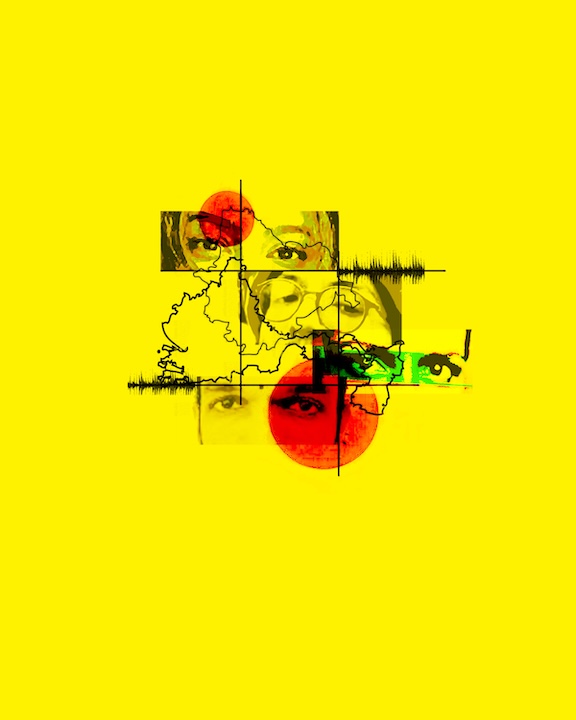
CHONG Li-Chuan (Singapore)
“On any given day” (2025)
On any given day, a city hums with the sounds of its own forgetting, Hong Lim Complex, once a site of forced separations and uncertain fates, now stands absorbed into daily life. In 1942, it bore witness to selections that determined who would walk free and who would disappear. Given by whom? Taken from whom?
In CHONG Li-Chuan’s “On any given day” (2025), a soundscape composition drawn from field recordings at Hong Lim Complex, history and the present converge through listening. The act of composition is an excavation — unearthing traces of a site repurposed and redeveloped. His grandfather’s story of a naive escape from death lingers within the work, folded into the city’s soundscape. We are the inheritors of those who survived. To hear is to resist forgetting. To sound is to remember those who have given us the day.
CHONG Li-Chuan (b.1975) is a Singaporean composer passionate about philosophy, culture and the arts. Li-Chuan's career in music and sound started in the late '90s, working as a composer and sound artist collaborating with practitioners in theatre, dance, spoken word, architecture, filmmaking, design and visual art. His creative output includes music composition, sound design, field recording, soundscape composition, site-specific art, installation, free improvisation, and collaborative work exploring conversations between different modes of expression and the poetics of sound.
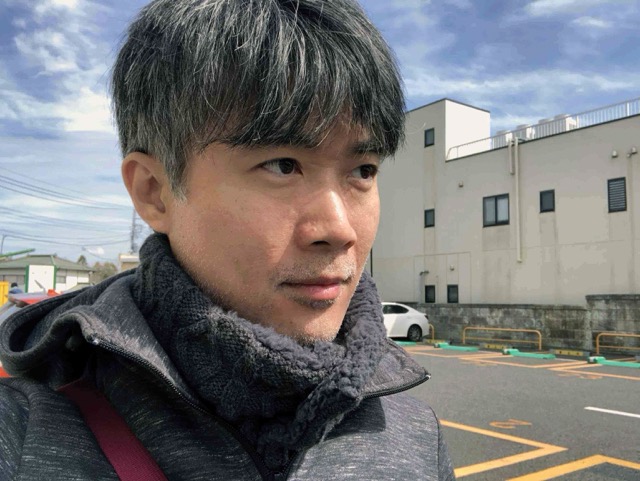
Mariana Pinto Coelho Dias (Portugal)
“Resonances of an Unheard Body” (2025)
Through sound, bodies expand beyond their visible contours. Following this line of thought, we can say that the “voice” is an extension of our body. This reflection leads us to question the limits of the extension of a human body: how far does a body extend? Who and what are part of it? What are the layers of its existence? Using the principles of Acoustic Ecology, and considering the human body as an undiscovered soundscape, the piece “Resonances of an Unheard Body” aims to highlight the relevance of 'sound' and 'listening' in perceiving the invisible layers of our existence. The aim is to question the conventional limits of the human body, making it collective, interconnected and permeable to others and to the sound environment that surrounds it. In the same way, this work investigates the relationship between the body and technological devices for capturing sound, as a fundamental factor in expanding our perception of the world. Technology is the resource that allows us to discover and navigate through all the layers of a body’s existence, combining and balancing them. Through it we can realize that, even though we are apparently nowhere, we can be everywhere our body extends. A body that has a plastic structure and behaves like water, changing its shape and adapting to the conditions that nature provides.
Mariana Pinto Coelho Dias is a Portuguese transdisciplinary artist, with artistic work in the field of sound art, experimental video, performance art, and audio-visual installation. Focused on sound studies, more specifically in the Acoustic Ecology, her work is prompted by the desire to contribute to balancing the weight between “sound images” and “visual images” in our perception of the world. She is currently a PhD candidate at the University of Fine Arts in Lisbon (FBA-UL), a research fellow from The Foundation for Science and Technology (FCT), and a member of The Artistic Studies Research Center (CIEBA). Exploring the practices of videoperformance and soundscape composition, she is developing an artistic research project entitled “Anthropophony: listening to the soundscape of an ‘expanded (human) body’ through videoperformance practices”, which seeks the possibility of a consistent engagement between “visual” and “sound images” for the perception of an “expanded (human) body”.
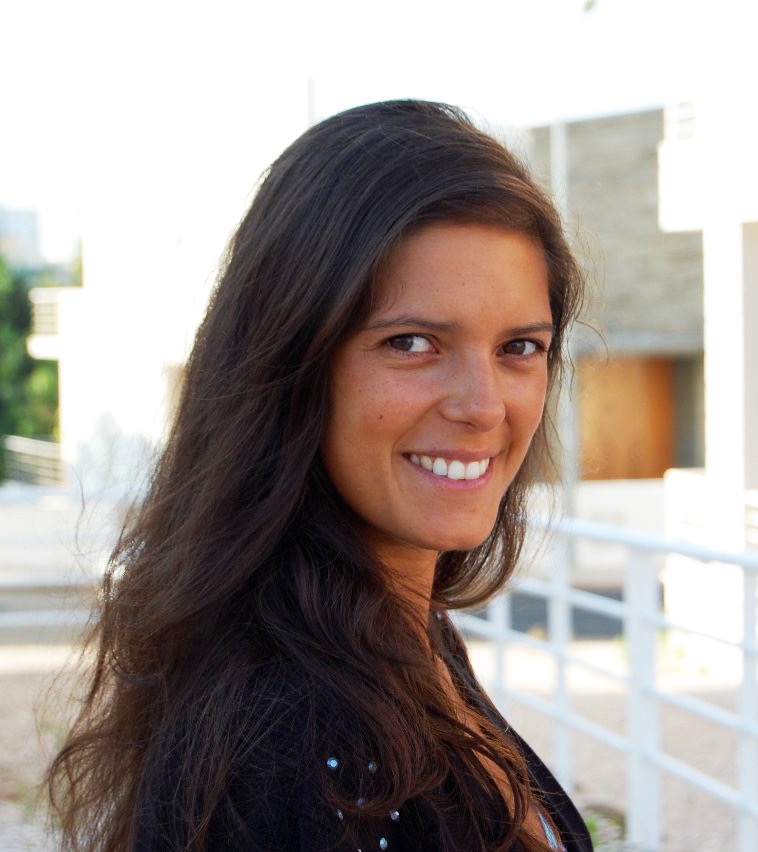
Čhoakkeladd (Kashmir)
“Payam-e-Čhoakkeladd” (Kashmiri for Message of the wounded) (2025)
We have a map, we have the inroads, we go in, come out and roll in between the two and you will never find out. Čhokkelad (wounded in Kashmiri), often used in the local news broadcasts when referring to victims of violent events. Payam e Chokkelede gathers the sounds produced while the acts of violence continue to unfold into the everydays. It’s news time.
Čhokkelad is eternally grateful to everyone who contributed to this project through equipment, care, time, effort and attention, and would like to credit Mu, Hi, U, E, Mo, Bu, Mukh, Ha, Ga, Sib and Eh.
Čhoakkeladd
Based in Kashmir, Čhoakkeladd’s work extends across media such as installation, video, sound, text and sculpture. Their work seeks to develop vocabularies of time and voids to pose questions on narrativization and history writing in contested territories.

Florence Cats / Lilja María Ásmundsdóttir (Belgium / Iceland)
“air” (2025)
“air” is part of the triptych air, water, fire, composed by artists Florence Cats (theremin, voice) and Lilja María Ásmundsdóttir (hulda, voice). Finding inspiration in the qualities of the natural elements, the new duo explores a wide range of frequencies, hybridizing electronic sounds and strings with breath and whistle.
“I was in Reykjavik in November when I received the invitation to take part in the biennial. I immediately had the vision of recording outside, the space, the whistling silence of the air. Air carries sound, air is the medium of sonic vibrations and, somewhere, we breathe sound every day. My first intention was to make field recordings, but it was very windy and my cheap equipment wasn't suited to the weather conditions. I was also fascinated by the way Icelanders internalize the vastness of the open air, one can feel it in their gaze, art and music. Having attended a concert by the musician and artist Lilja María Ásmundsdóttir, I felt a direct resonance and offered to collaborate with her on my next visit. When I returned in February we played together and the connection proved to be sensitive, musical and telepathic. We decided to work on a tryptic, drawing inspiration from the energies of air, water and fire that shape Iceland and correspond in us to the three alchemical foci. I'm also an acupuncturist, placing needles at precise points on the body to attune inner energy movements to celestial and terrestrial flows.”
Florence Cats
Florence Cats' work evolves between sound, music, poetry and visual art. Her research concerns the elusive, in relation to perception and notation. She plays the theremin experimentally, interacting with voice, breath, water, radio and tiny handmade instruments. She is also acupuncturist and art curator. In 2023, she was selected as a Belgian emerging sound artist. Her releases are based on field recordings, resulting from free processes, open to nature or to other artists: shell I (Ediçoes CN, 2025), Ys (2022), We are now approaching Mo i Rana (Ftarri, 2024) and Correspondances (Frissons, 2021). She was part of The Asocial Telepathic Ensemble (Corvo Records, 2021) with the piece In the air. She is also an art curator and acupuncturist.
Lilja María Ásmundsdóttir is an artist, composer and performer from Iceland. Her practice is centered on explorations of collaborative creativity. Working with sculptural elements of sound and matter, she creates installations, audio-visual pieces, and performances. The works are actively designed to facilitate continuous processes that highlight how ideas surface from correspondences with materials, between individuals, and in context to one’s surroundings. Her works include the sound and light sculpture Hulda which was nominated for the President’s Student Innovation Award, and the living sound sculpture Lurking Creature which she developed in collaboration with the dancer Inês Zinho Pinheiro.
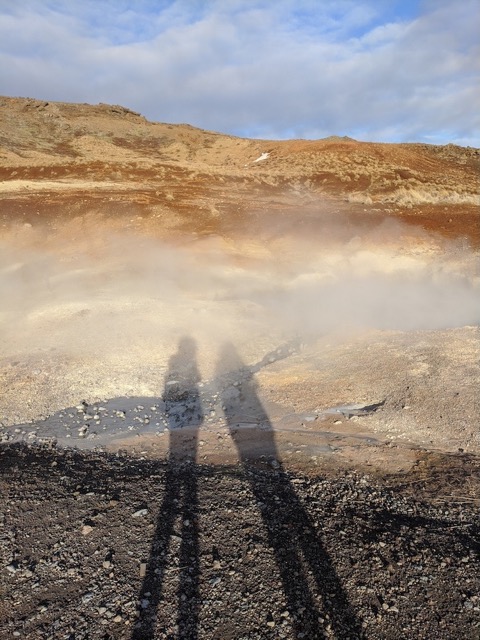
MycoDyke (India)
“As Above, So Below” (2025)
This work is an attempt to hold space for ecological mourning. My practice – and my life – is rooted in fungi and decomposition, through which I’ve come to understand death as a transition: a process that nourishes, reshapes, redistributes, regenerates. But in the summer of 2025, Delhi experienced an early and catastrophic monsoon. Trees died in great numbers, leaving behind stumps, sap-dripping wounds, split trunks, and exposed roots. Their bodies were chopped up and cleared away within days – before fungi could begin their quiet work of unmaking. This was a process cut short: abrupt, arrested, incomplete. There was no rot, no decomposition, no transformation. Just silence.
This work sits with that silence.
In my recordings are the sounds of thunderstorms and post-storm stillness; quiet, fragmented voice notes and soft conversations with the trees; the funerary lament of peacocks; and a need to sense the unseen presences just below the surface. Together, they form an embodied eulogy. A murmur. A staying-with.
To grieve publicly, across species lines, is to me an act of political listening – a refusal to rush on, a refusal to forget. It is this practice of interdependency and “shared worlding” that Third Listening invites, and that this work hopes to embody.
MycoDyke is the fungal alter of Malavika Bhatia, a self-taught field mycologist, artist, and community facilitator. Through their engagement with fungi, they weave together ethnomycological research, community-based practices, and theoretical frameworks to reimagine relationships to place, community, and the more-than-human world. Their living installation ‘Rot & Rapture: Decomposing Binaries’ at Gender Bender 2024 combined fungal cultures with prose and poetry, guiding audiences through intimate dialogues with fungal bodies to examine dissolution as a pathway to fluid states of being. Their art books, including “Fungal Hermeneutics: (De)Compositions in the Academic Forest” and “The 'Other' Underground: A Zine of Fungal Queeriosities,” transform academic concepts into affective narratives that propose alternative understandings of queerness in ecology. Drawing on mycelial networks as both metaphor and method, they have developed participatory experiences at Science Gallery Bengaluru, Kiran Nadar Museum of Art, Serendipity Arts Festival, and others, challenging conventional narratives about ecology, community, and belonging.
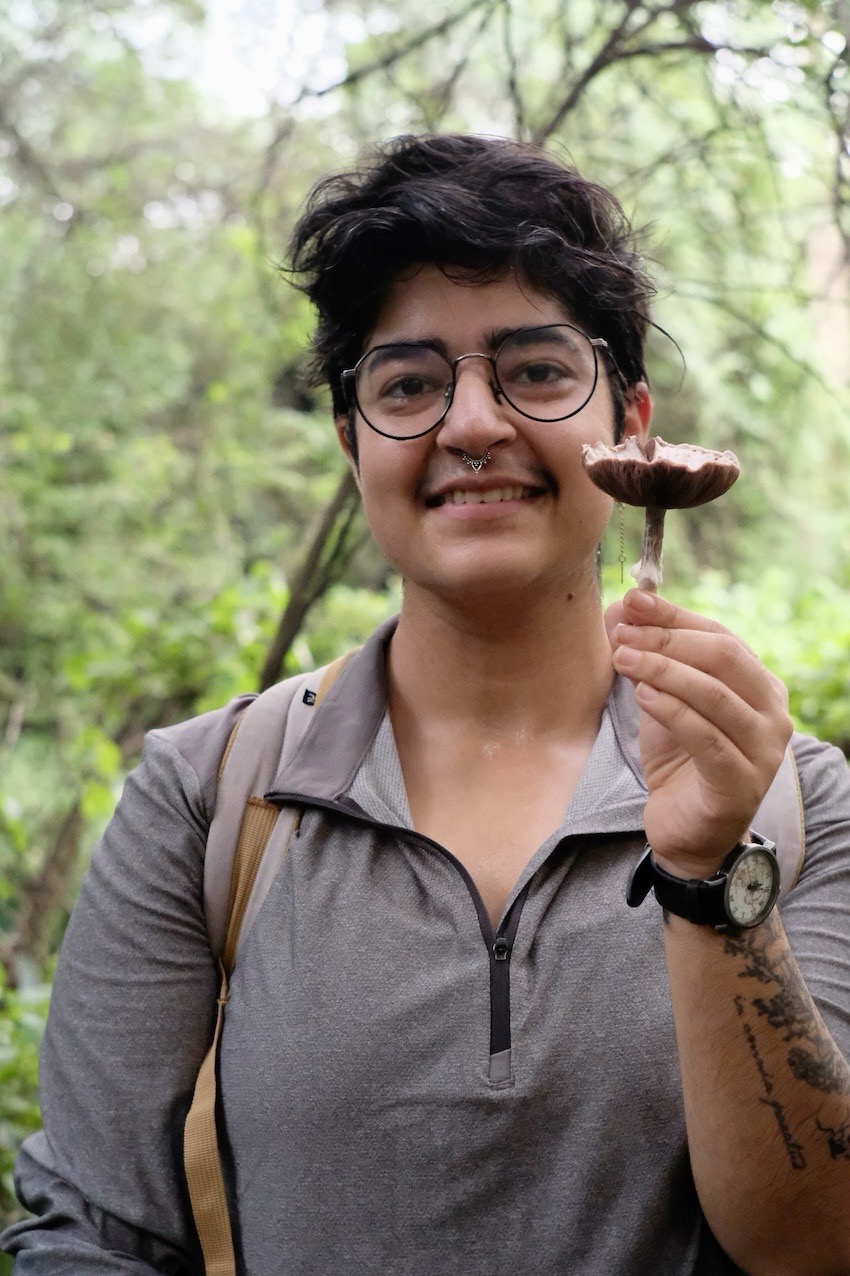
Hear & Found (Thailand)
“Earthsong: Indigenous Harmony from Thailand (Nature soundscape from rotation farming at Maeporkee community)” (2024)
Recorded in the Maeporkee community in Tak province, Northern Thailand, this soundscape captures a significant aspect of the Karen people's traditional way of life: rotational farming, a method rooted in regenerative nature and sustainability. Rotational farming involves the Karen people collectively selecting a communal plot of land for rice cultivation. Before commencing, they perform a ritual to seek permission from Mother Earth. Once granted, they clear the vegetation and prepare the land, planting seasonal vegetables like chilli, coriander, squash, etc. Around mid-year, they cultivate rice, with the harvest typically occurring in November. These crops sustain their families for the entire year. Afterwards, the land is left fallow for three to seven years, with the community returning only to pay respects to the land. This cyclical method naturally produces organic food without chemicals, embodying principles of regenerative agriculture. The Karen people allow plants to grow seasonally and harvest what the season provides, refraining from controlling or harming any living organisms, showcasing a deep understanding of ecological balance. Unfortunately, this traditional knowledge is fading in many Karen communities due to land rights issues, a decline in younger generations continuing the practice, climate change, and the rapid advancement of agricultural technology. There is a concern that this harmonious and sustainable method of living and producing organic food may disappear someday. Deeply impressed by the Karen people’s dedication to preserving this agricultural method for themselves and future generations, the Hear & Found team recorded this soundscape on the morning of September 2024, during the lush green field season before the harvest. In this track, listeners can immerse themselves in the natural sounds of birds chirping, the gentle breeze, and the rustling of the rice field as it sways in the wind, a testament to their sustainable way of life. This soundscape is one of four soundscapes from their Earthsong series, which interweaves sounds of natural environments and music and song from the Karen and Karen Pwo groups.
Hear & Found, a sound collective co-founded by Thai artists Ms. Sirasar Boonma and Ms. Pansita Sasirawuth, was established in Thailand in 2018. Driven by a passion for amplifying marginalized voices, primarily within Thailand, the team creates immersive installations and field recordings to bridge cultural gaps and foster understanding. Their work centers on ethical collaboration with indigenous communities, preserving unique soundscapes and musical traditions. Focusing on sustainability and cultural identity, Hear & Found blends artistic innovation with social impact. They document and share often-overlooked sonic narratives, promoting empathy and awareness. In these six years, their projects have created accessible platforms and reached more than 250,000 people worldwide, working with more than seven ethnic groups and involving over a hundred individuals from these ethnic groups, ensuring that indigenous voices and their rich cultural heritage are heard and celebrated by contemporary audiences.
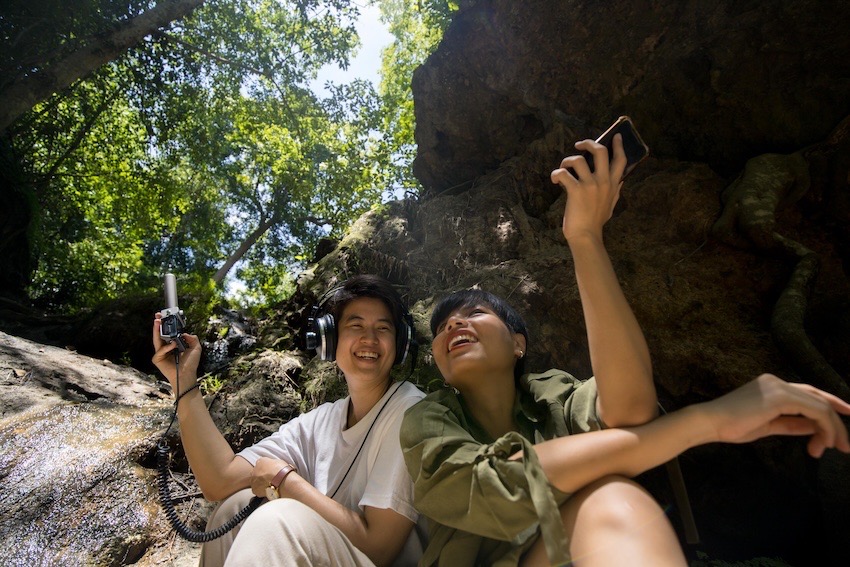
Shwe Wutt Hmon (Myanmar/Thailand)
“Noises Are Quite Loud Here” (2023–ongoing)
This project began as a spontaneous response to my transition from urban life, heightening my awareness of nature's subtleties—plants, animals, and landscapes. It also reflects my ongoing exploration of various forms of "NOISE," from the hallucinated sounds I battle to the suffocating air pollution during Chiang Mai's notorious smog season. The work consists of a photographic and video installation accompanied by a sonic soundscape, blending analogue photography with scanner-generated images to depict noise's overwhelming presence in the environment. Color and monochrome images, captured through deliberate and unhurried analogue photography, document my daily explorations of Rimbun Dahan, a 14-acre tropical garden near Kuala Lumpur. Scattered flowers, leaves, and deceased insects gathered from the garden are thoughtfully combined with archival materials on environmental degradation and chaotic social noise, adding depth through scanner imagery.
“Noises Are Quite Loud Here” is a personal introspection on how noise intensifies even in seemingly tranquil environments. It contemplates the profound damage humans have inflicted upon nature and questions whether there is still a chance to mend and protect our ecosystem.
Shwe Wutt Hmon is a photographer and mixed media artist from Myanmar, currently based in Thailand. Shwe’s work focuses on collective histories, familial ties, the knots and threads of human relationships, and exploring the inner psyche through intimate storytelling about people and places dear to her heart. She tells personal stories to connect with and examine broader social aspects; conversely, she works on social documentaries reflecting and drawing from her own position within the context. Shwe uses photography as her main medium and incorporates archives, videos, texts, sounds, poems, paintings, and drawings of her own or in collaboration with others. Shwe’s works have been exhibited in festivals and spaces such as Kochi-Muziris Biennale 2020, Aichi Triennale 2022, Thailand Biennale, Chiang Rai 2023 with 'Zomia Pavilion', Singapore International Photography Festival 2020, Photo Australia International Festival of Photography 2022, ArtScience Museum Singapore, Bangkok Art & Culture Centre, Photoforum Pasquart, and Foam Amsterdam.
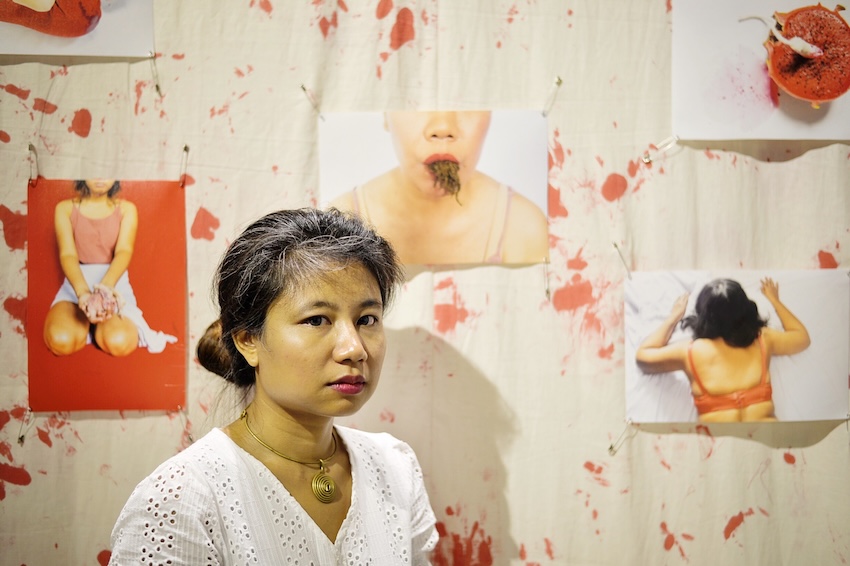
Lynn Nandar Htoo (Myanmar/Cambodia)
“Neural Net Nocturne” (2025)
The concept of “home” extends far beyond physical boundaries, encompassing the complexity of memories, cultural touchstones, and deeply ingrained emotional connections. It's the scent of familiar spices wafting through the air, the rhythmic cadence of a native tongue, the shared rituals that bind generations. These intangible elements form the bedrock of identity, anchoring individuals to their roots even when geographical distance separates them. Yet, the experience of displacement, whether forced or voluntary, can create a profound sense of dissonance. The comforting familiarity of home becomes a phantom limb, an echo of what once was. In its place, a new reality emerges, one that requires adaptation and resilience. The process of navigating this liminal space, between the known and the unknown, can be both challenging and transformative. It necessitates the construction of new communities, the forging of new connections, and the discovery of unexpected strengths. Ultimately, the meaning of home evolves, becoming a fluid concept that transcends physical location, residing instead in the heart and the mind.
Lynn Nandar Htoo a.k.a LnHD is a sound designer, music producer, and DJ originally from Myanmar and now based in Phnom Penh. Named Goethe’s Talent 2024, she has brought her minimalistic and percussive Southeast Asian experimental club sound to international stages, including Berlin’s Pop-Kultur Festival. She has performed in clubs & festivals across Southeast Asia in cities like Yangon, Saigon, Bali, Jakarta, Kuala Lumpur, Hanoi, Bangkok, and Phnom Penh. Her work explores the intersections of identity, culture, and sound, with releases like Jamadevi on the acclaimed Indonesian label Yes No Wave and SLAVE INSTINCTS on ALIGN.ONLINE, a platform celebrating femme and queer voices in Southeast Asia. As the winner of Radio Lab, LnHD continues to redefine boundaries in Southeast Asia’s electronic music scene and she has performed at the renowned CTM Festival, further establishing her reputation as a rising force in the global experimental music scene.
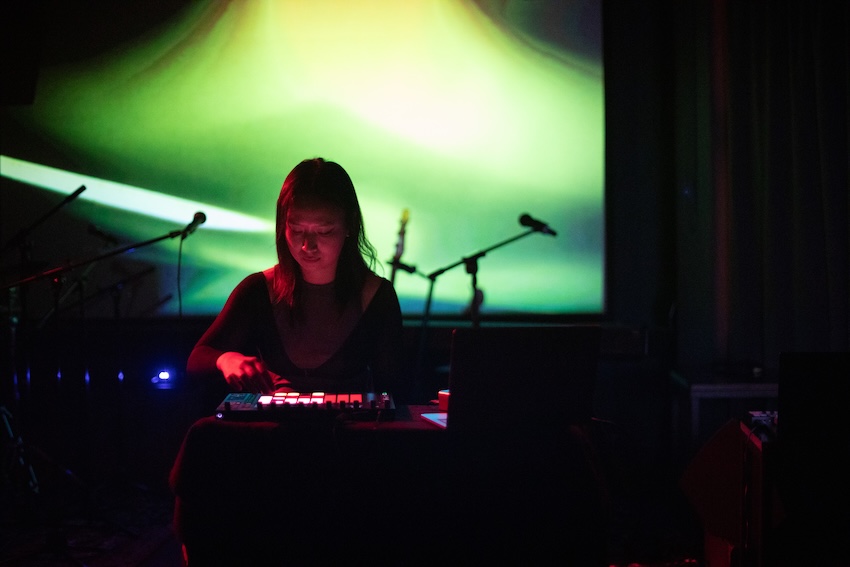
LSAC (Lagos Sound Artists Collective) (Nigeria)
“Perceptions” (2025)
In some parts of the world, thousands of children are exploited in illegal operations, particularly in the extraction of cobalt, gold, and other valuable minerals that are crucial for global industries, including electronics and electric vehicle batteries. However, much of this mining occurs under dangerous and unregulated conditions and mostly involving child labor. Some call it Essential or Unavoidable reality of the global supply chain because they believe that Certain evils should be maintained because eliminating them would challenge the status quo. Are we saying that some communities should keep suffering and impoverished for some other communities to usurp power?
Contributing Artists: Ibukun Sunday, Michael Akinyele, Babatunde Goodluck, Esther Essien, Olatunde Obajeun and Tosin Oyebisi.
Lagos Sound Artists Collective (LSAC) is an unconventional movement dedicated to reshaping the landscape of auditory experiences through innovative sound exploration. LSAC is committed to fostering a vibrant community of sound artists from Lagos and beyond, while pushing the boundaries of art performance. Through participatory workshops, immersive installations, and spontaneous sonic happenings, LSAC aims to engage audiences in a multi-sensory exploration of sound. Some of their recent works and gatherings include: Sonic Flux, an afternoon of experimental sound in collaboration with Art Twenty One gallery Lagos (2023); Ideas Lab, a dynamic studio designed for diverse performances and experimental works, co-curated for Afropolis Lagos (2024); and Echoes and Balance, an immersive experience where sound meets personal well-being in collaboration with J Randle Centre Lagos (2025).

Okui Lala (Malaysia), Ana Estrada (Mexico/Australia), & Nasrikah (Indonesia/Malaysia)
“Re-Listening Care” (2025)
Re-Listening Care revisits Re-Imagining the Workplace (2024), a live performance created by Okui Lala, Ana Estrada, and Nasrikah, in collaboration with caregivers Uli, Arni, Ryanie, Diane, Leeanne, Madison, Rosie, Dipin, and Khushi. Originally performed on December 1, 2024, at QAGOMA (Australia), the event brought together aged care workers to share their experiences and collectively rethink care work. By replaying Act I: It is a home—the first of four acts from the original performance—Re-Listening Care extends the conversation to a second audience, highlighting how care work—often unseen and unheard—deserves ongoing attention. Through listening as an act of care, this work invites audiences to engage with the labor, emotion, and resilience embedded in caregiving and to view dialogue as both a form of recognition and a place for change.
Okui Lala, Ana Estrada, and Nasrikah work together across countries meeting online to exchange ideas and develop projects centered in dialogue, storytelling, and social justice. Okui often collaborates with family, friends, workers, and those around her to explore identity, diaspora, and belonging. Ana works with aged care residents and caregivers, exploring storytelling as a tool for connection. Nasrikah, the founding member of PERTIMIG, advocates for the rights of Indonesian domestic workers in Malaysia. Their collaboration is driven by a shared commitment to care, equity, and collective action—along with a genuine enjoyment of working together! Beginning with Re-Imagining the Workplace (2024) and continuing with Re-Listening Care (2025), they create spaces for conversations that challenge and reflect on systems of labor and care.
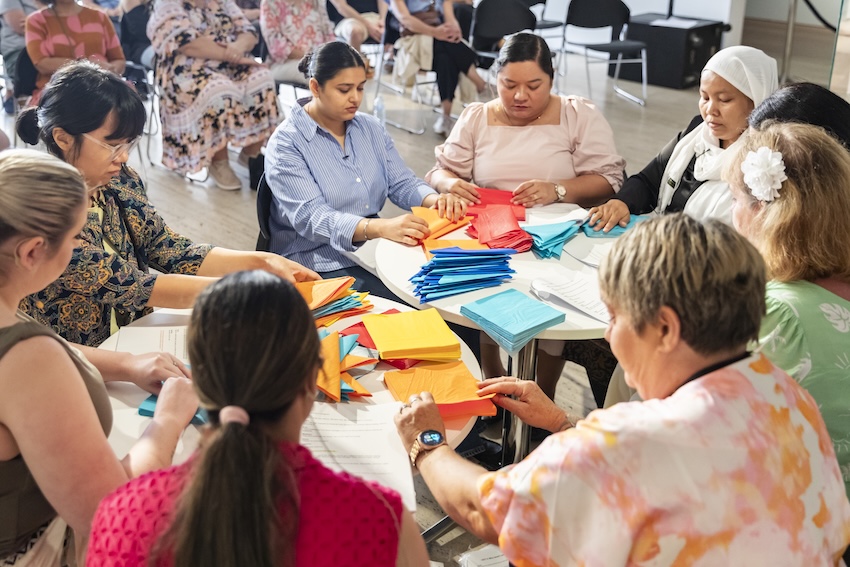
Nicole L’Huillier (Chile/Germany)
“Vientos colectivos” (2025)
La Orejona interacts with phenomena such as sound waves in the air, caresses from the wind, tremors from the ground, and oscillations induced by touch from both human and non-human entities. In contrast to regular modern microphones that are made to target individual signals, La Orejona operates with the purpose of weaving independent signals into a collective and inseparable noise, a thick mass of convoluted muddy sound. La Orejona is a microphone of noise, a rubbery listening apparatus that centers on the poetics of unintelligibility. It is not intended to be a precise measurement device—on the contrary, it is a device for confusing signals, fuzzing, mixing up, and obscuring. By doing so, La Orejona aims to explore the world through a vibrational logic in order to fuzz the rigid paradigms and lines that delineate our imaginations. This is an invitation to pay attention to other codes so we can rearticulate our relational ways and the narratives that define us; so we can tune into our vibrational realities.
La Orejona enabled a mobile and outdoor recording studio for socio-natural arrangements and collective improvisation sessions through different processions and collective sessions that invite for vibrations and interaction with the audience, resonances from the spaces it transits in, sounds from the place, the wind of the place, voices, wind instruments, synthesizers, touch from trees and plants, the waves from the water, and other entities and vibrational forces around her.
This piece was composed using as a source the recording from a collective improvisation procession with La Orejona (XS)—who served as a mobile recording membranal studio. This session took place indoors and outdoors on a rainy and windy night in November 2023 at Morphine Raum in Berlin as part of the Radical Sounds Latin America Festival. Infinitas gracias a todxs por resonar con nosotras y activar en conjunto una ruidosa comunidad en movimiento.
Nicole L’Huillier is a transdisciplinary artist and researcher from Santiago, Chile. Her practice centers on exploring sounds and vibrations as construction materials to delve into questions of agency, identity, collectivity, and the activation of a vibrational imagination. Her work materializes through installations, sonic/vibrational sculptures, custom-made (listening and/or sounding) apparatuses, performances, experimental compositions, membranal poems, and writing. She holds a Ph.D. in Media Arts & Sciences from MIT (2022). Her work has been shown at the 60th International Art Exhibition – La Biennale di Venezia (2024), Kunsthalle Bern (2024), Ming Contemporary Art Museum (McaM), Shanghai (2023), ifa-Gallery Stuttgart (2023), Bienal de Artes Mediales Santiago (2023, 2021, 2019, 2017), Staatliche Kunsthalle Baden-Baden (2022), Transmediale, Berlin (2022), Ars Electronica, Linz (2022, 2019, 2018), Museo de Arte Contemporáneo (MAC), Santiago de Chile (2022), 6th Ural Industrial Biennale, Ekaterinburg (2021), and 16th International Architecture Exhibition – La Biennale di Venezia (2018), among others.
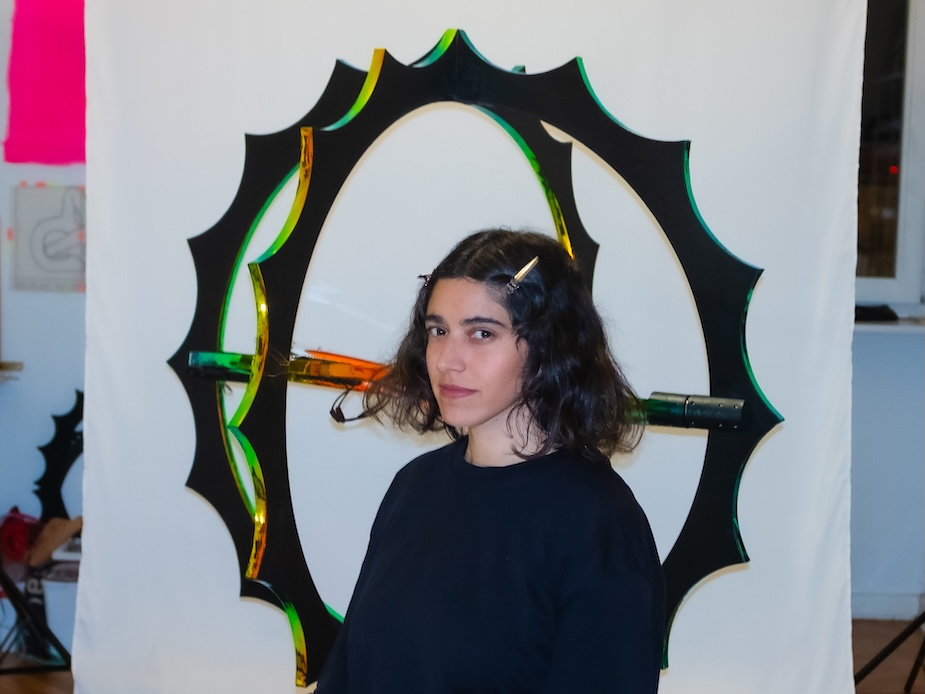
Subash Thebe Limbu (Limbuwan, Nepal/United Kingdom)
“Sound Recordings of Time Travellers” (2025)
This work incorporates both used and unused sounds from the artist’s previous pieces Ningwasum (2021) and Ladhamba Tayem; Future Continuous (2023), as well as materials from unrealized projects. Both earlier works feature time travelers from the Indigenous Yakthung (Limbu) Nation of the distant future: in Ningwasum, Miksam journeys to our timeline in search of her father, while in Ladhamba Tayem, Mikki travels back to 1774 CE to meet the Yakthung warrior Kangsore, who fought against the invading colonial Gorkha army.
The piece blends Indigenous Yakthung melodies and language with electronic music, field recordings, the sounds of handloom, and excerpts from legendary Yakthung singer Bhagat Subba’s song. Toward the end, the sound work features a clip from Ningwasum of Yangdang Phongma—a Yakthung naming ceremony where a newborn is blessed and shown the sun, moon and stars for the first time. Here, the time traveler remembers the blessings her mother once gave her:
Be skilled in weaving time,
Be fast as the speed of light,
Be bright as Tanchhoppa,
Be intelligent and kind.
Speak thousands of languages,
Think in hundreds or more.
Never be afraid to move forward,
Never forget your past though.
May you travel to many stars,
May the stars welcome you as I did.
In times of despair and sorrow,
Let it pass through you,
And live for a better tomorrow.
For I will always be with you—
Even if you’re lightyears away,
Even if you’re in another time,
I will love you to the Milky Way.
Time travellers:
Miksam – Manu Nembang (Ningwasum, 2021)
Mingsoma – Bimala Khajum Limbu (Ladhamba Tayem; Future Continuous, 2023)
Kangsore – Aashish Aveng Limbu (Ladhamba Tayem; Future Continuous, 2023)
Bhagat Subba (Hakpare, Yakthung Samlo)
Jhuma Limbu (Theme song from Ladhamba Tayem; Future Continuous, 2023)
Backing vocals – Tirshana Nembang, Rojina Thegim, Dipa Suhang, Bibas Nembang, Amrit Kumar Bhatta, Laxman Limbu
Subash Thebe Limbu is a Yakthung (Limbu) artist from Yakthung Nation (Limbuwan), located in present-day eastern Nepal. He works with sound, film, music, and painting. His Yakthung name is ᤋᤠᤱᤛᤠᤱ Tangsang (Sky). Drawing from socio-political issues, resistance and science/speculative fiction, his works engage the notion of time, climate change, and indigeneity through the critical lens of Adivasi Futurism, a framework he has been developing over several years. His recent projects, Ningwasum (2021) and Ladhamba Tayem; Future Continuous (2023), have been presented at major international platforms including Tate Modern (London), the Asia Pacific Triennial (Brisbane), and the Sharjah Biennale (Sharjah), among others. Subash is a co-founding member of Yakthung Cho (Yakthung Art Society), and is currently based between Kathmandu (Newa-Tamsaling) and the United Kingdom.
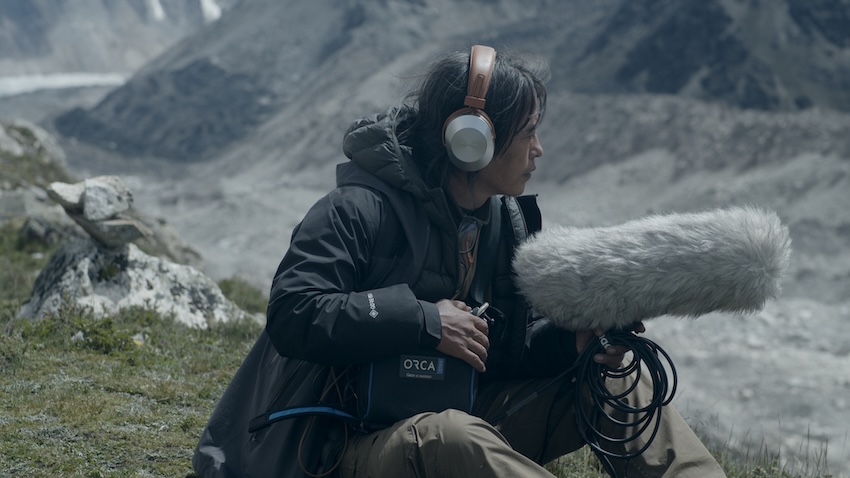
Elena Lucca (Argentina)
“Habitar, Cohabitar, Rehabitar para el Reencantamiento” (2025)
The song, the word, the wind, the night, the movement, the sound of the voice, the silence, the calm, other voices dialoguing, a space where everything happens in a musical moment, which recalls “l’environnement suspendu ou l’épochè” by Jean-François Augoyard (1990), the elision, the suspension of perceptual customs, object categorizations and preconceived ideas to listen to what happens in the cohabited space and reinhabit the place as a poetic process of sensitive knowledge. In Resistencia, a city in the Gran Chaco region of South America, during the month of March 2025, the temperature remains constant between 40 and 43 degrees Celsius for 25 days. Plant and animal species, as well as humans, gradually slow their vitality over the course of the days, falling into a kind of lethargy, waiting, in silence, from which we all emerge at the beginning of autumn, with the appearance of gentle rains, a decrease in temperature, and an increase in humidity. Movement and sounds slowly return. In this transition, everything is fluid; evanescent forms begin to define themselves again; receptive identities become permeable to other identities, joyful, celebratory, and eager to dialogue. In the process of re-inhabiting the place, suspense and rebirth emerge in the perception of the countless subtle exchanges and the complexity of the web of relationships within the place. Each event follows its natural course, forming an enveloping whole. A continuous metamorphosis, the cycle of the living, the Tao. The poetics of the world of life thus becomes a Re-enchantment.
Elena Lucca is an artist and environmental educator. She holds a Ph.D. from the University of Avignon, France, in Space, Time, and Power, Cultural Practices. She has worked as an environmental educator at both Argentine and Italian universities. Since 1990, she has served as a guest lecturer at the CAIRH – Roy Hart International Artistic Center in France. Since the 1960s, Lucca has explored experimental poetic forms, notably through video art presented in various countries. She also organized the Jornadas Internacionales de Poesía (JOPOE) for the National University of the Northeast (UNNE) in Chaco in 1969, and in 1971 co-curated the International Exhibition of Proposals to Be Realized with Edgardo A. Vigo for the CAYC – Center for Art and Communication in Buenos Aires. Drawing on her experiences working in and with forest communities, Lucca has developed an environmental experimental poetic line known as Geopoetry of the Spaces We Inhabit. This work has been featured in exhibitions including: The Re-enchantment (2016), Timeless Spaces: An Ecopolitical Poetics of the Places We Inhabit (2019), The Space We Inhabit: Earth (2021), The Space We Inhabit: Air (2021).
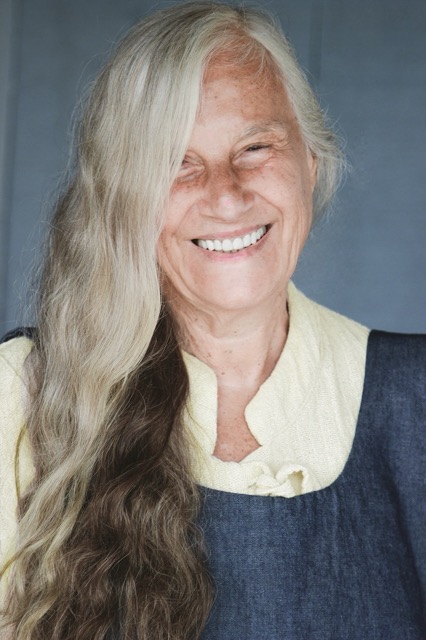
Imaad Majeed (Sri Lanka)
“Questions of Jailani” (2025)
Questions of Jailani is a sound-based artwork that explores the contested sacred site of Dafther Jailani in Kuragala, Sri Lanka—a place where overlapping mythologies, militarized nationalism, and religious orthodoxy converge to distort plural histories. Once an overflowing Sufi shrine, Jailani has become a battleground of authenticity—Sinhala Buddhist nationalists seek to reframe it as a prehistoric archaeological site devoid of Muslim presence, while orthodox Sunni factions reject its mystical practices as idolatry. In this struggle over origins, shared memory is dismantled to make way for singular, purified narratives.
This work, constructed from field recordings gathered in collaboration with artist Abdul Halik Azeez, listens closely to the space. A military personnel sweeps the grounds while Buddhist chants echo faintly. We hear the sounds of nature as the invocation “ameen” is stretched into a spectral resonance, unsettling the boundary between human and non-human utterance.
Inspired by a caretaker’s account of encounters with the jinn of nearby Jinni Malai, who claimed the politics of our realms are interconnected, the work considers listening as a method of resistance and speculation. In an attempt to hear the more-than-human realm and the unresolved memory it holds, it asks: What is the sound of Sinhala Buddhist colonization? What survives in the silence now that the fakhirs no longer dwell there? Questions of Jailani is not a restoration of lost sound, but an invitation to attune to what remains: echoes, hauntings, and entanglements across time, faith, and species.
Imaad Majeed is a multidisciplinary artist, curator and writer based in Colombo, Sri Lanka. They are Director and Curator of the trilingual performance platform “KACHA KACHA”. They are one part of the artist collective “The Packet” and VJ/DJ of “Packet Radio” (SUPR FM). They are Project Coordinator and Co-Curator of Thattu Pattu, a platform for music from the fringes of Sri Lanka. Their poetry has been published in Out of Sri Lanka: Tamil, Sinhala and English poetry from Sri Lanka and its diasporas, CITY: A Journal of South Asian Literature, as well as the local small-press chapbooks Lime Plain Tea and Annasi & Kadalagotu. Their artwork, in various mediums, has been featured at Tamil Studies Symposium, Queer Tamil Collective, Colomboscope, Chobi Mela, Queer Arts Festival, Serendipity Arts Festival, Museum of Modern and Contemporary Art Sri Lanka, BuchBasel, and Spielart Theatre Festival, among others. They are presently working on KANNOORU, exploring Sri Lankan Sufi/Muslim identity, community, memory, erasure, ancestry, and mysticism through sample-based music.
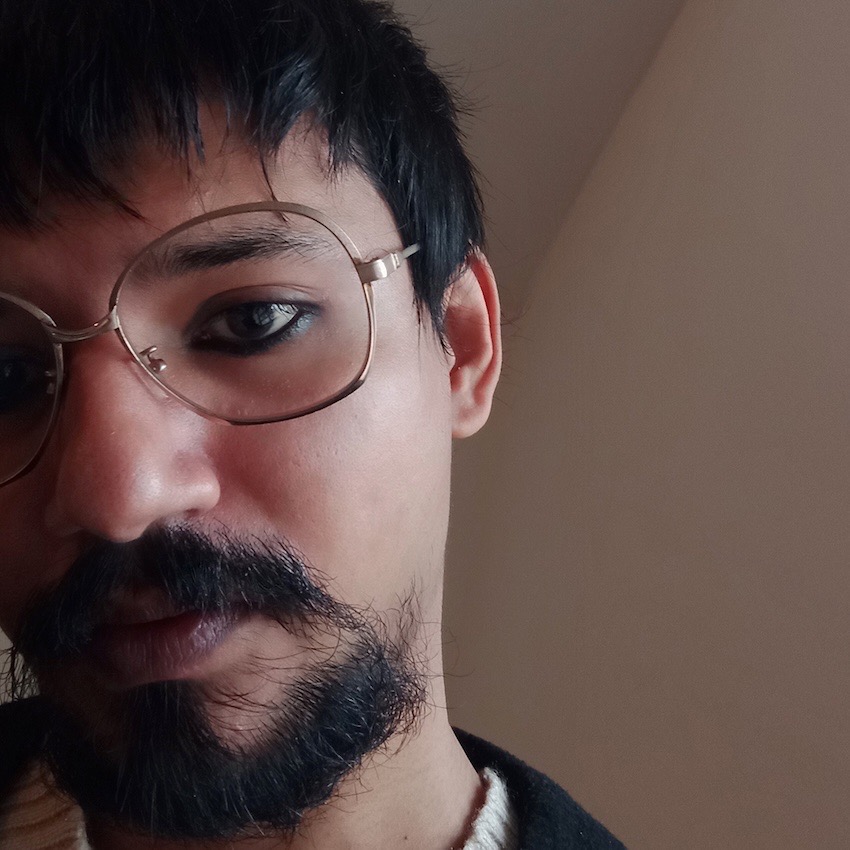
Yara Mekawei (Egypt)
“Feed on Wasted Energy” (2025)
A plate: rice, tomato, broccoli, grapes—
bacon’s grease bleeding into pomegranate molasses.
Arugula wilts under the weight of silence.
Three girls. A man of forty winters.
Yellow light pools behind him, a dim coronet,
as he dissects his meal—slow, methodical—
unmoved by untouched plates, by glances
stitched in secret between daughters.
Years grind like tectonic plates here:
no accidents, only faith’s brittle geometry.
Everything interlocks. Nothing happens—
until the door cracks open.
A stranger arrives, unannounced.
Chef—they murmur—his beard a sculpture
of charisma, laughter coiled in his throat.
The room stiffens. Minutes drip like wax.
Then, his demand: A cup of milk.
He plucks it from the man’s grip, smirks:
I smoked here once. Drank milk. No law
but my own.
Wild law unfolds—
a parallax of gazes. Now, all frames shift:
each body a galaxy in motion, velocity constant,
paths straitjacketed yet relative. No anchor.
No axis absolute. Only the algebra of collision:
milk spilled, smoke lingering, plates orbiting
the gravity of what goes unsaid.
Yara Mekawei is a sonic artist and scholar exploring the intersection of sound, architecture, and urban landscapes. Her work transforms the rhythm of cities into immersive auditory experiences, where sonic narratives merge with visual form. Rooted in deep research, Mekawei bridges antiquity and modernity, drawing from Sufi philosophy and The Book of the Dead to craft compositions that resonate with memory, identity, and cultural heritage. Her practice dissolves boundaries between past, present, and sonic visions.
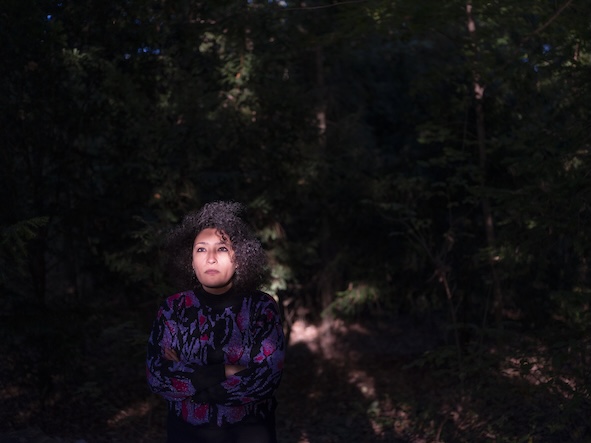
Graciela Muñoz (Chile)
“In a cloud” (2025)
“In a cloud” emerged from the Omora forest, in the sub-Antarctic region of Chile, in 2025. At that time, we experimented with field recordings and transmissions: signals, feedback, and transfers in interconnections with insects, mosses, lichens, and objects found there. “In a cloud” is a fragment of that immersive experience.
Graciela Muñoz (Chile, 1982) is a composer, performer, and researcher, Master in Media Arts and PhD in Philosophy from the University of Chile. She obtained a specialization in electroacoustic composition at the Phonos Foundation in Barcelona. Her work brings together multiple media, spectra, and materialities found in diverse contemporary ecologies. She is currently working on her postdoctoral research project at Parque Omora, located in the sub-Antarctic region of Chile.
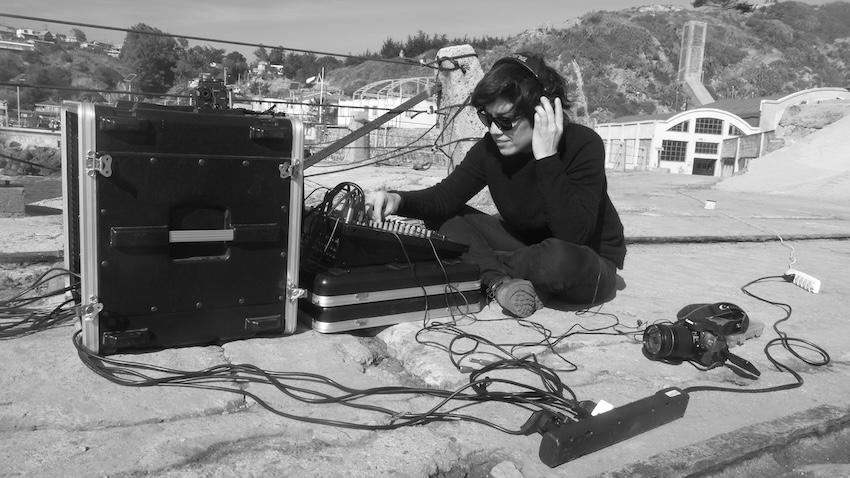
Jacqueline Nova (Belgium/Colombia)
“Creación de la tierra” (1972)
Creación de la tierra is a piece that can be classified as “tape music” or “electroacoustic music for fixed media”; however, the composer consistently emphasized describing it as a work “for electronically transformed voice”. It was composed using archival material, featuring a fragment of one of the chants of the creation of the earth, in the voice of an Indigenous person from the U’wa ethnic group (Boyacá, Colombia).
It is a ritual in which, through listening, words undergo constant metamorphoses; they overflow from the voice to transmute into bodies, memories, territories. In every step of the 19-minute ceremony, the voice takes us to encounters with other forms of existence—visible, invisible, tangible, unknown, familiar, ancestral. This voice guides us initiatically through worlds, both human and non-human, through earthly, spectral, or transitional interstices. This creator chant invites us to embody forest, wind, insects, percussion, choir, river, night. The voice of a community to which Nova does not belong and the words of a language that is not her own are interwoven without exoticism and gain profound symbolic value by being amplified in a context that has historically marginalized them. Nova strongly reaffirms the right to coexist as equals and the necessity to exist without exclusions.
Text by Ana María Romano.
Creación de la tierra, 1972 courtesy of the Centro de Documentación Musical de la Biblioteca Nacional de Colombia.
Jacqueline Nova (Ghent, Belgium, 1935 – Bogotá, Colombia, 1975)
Jacqueline Nova arrived in Bogotá in 1958 after living in Bucaramanga, her father’s hometown. She settled in the capital to study to become a pianist at the National Conservatory of Music. However, in 1963, she focused on composition. She was the first female composer to earn a diploma from the Conservatory. In 1967, she won a scholarship to study at the CLAEM (Latin American Center for Advanced Musical Studies) of the Torcuato Di Tella Institute in Argentina.
Throughout Nova’s artistic creation, it is evident her great fascination with the human voice, electronic media, and mixed instrumental combinations—those in which acoustic instruments are intertwined with electronic media. For her, electroacoustic resources had to be integrated into the sonic universe of contemporary creation without mystery, as another musical material that could dialogue organically with acoustic instruments. Creación de la tierra emerged at the Phonology Studio of the Faculty of Architecture, University of Buenos Aires in 1972. She died in Bogotá of bone cancer. Her tragic and early death not only cut short a career at the height of her creative potential, but also directly affected the development of electroacoustic music in Colombia.
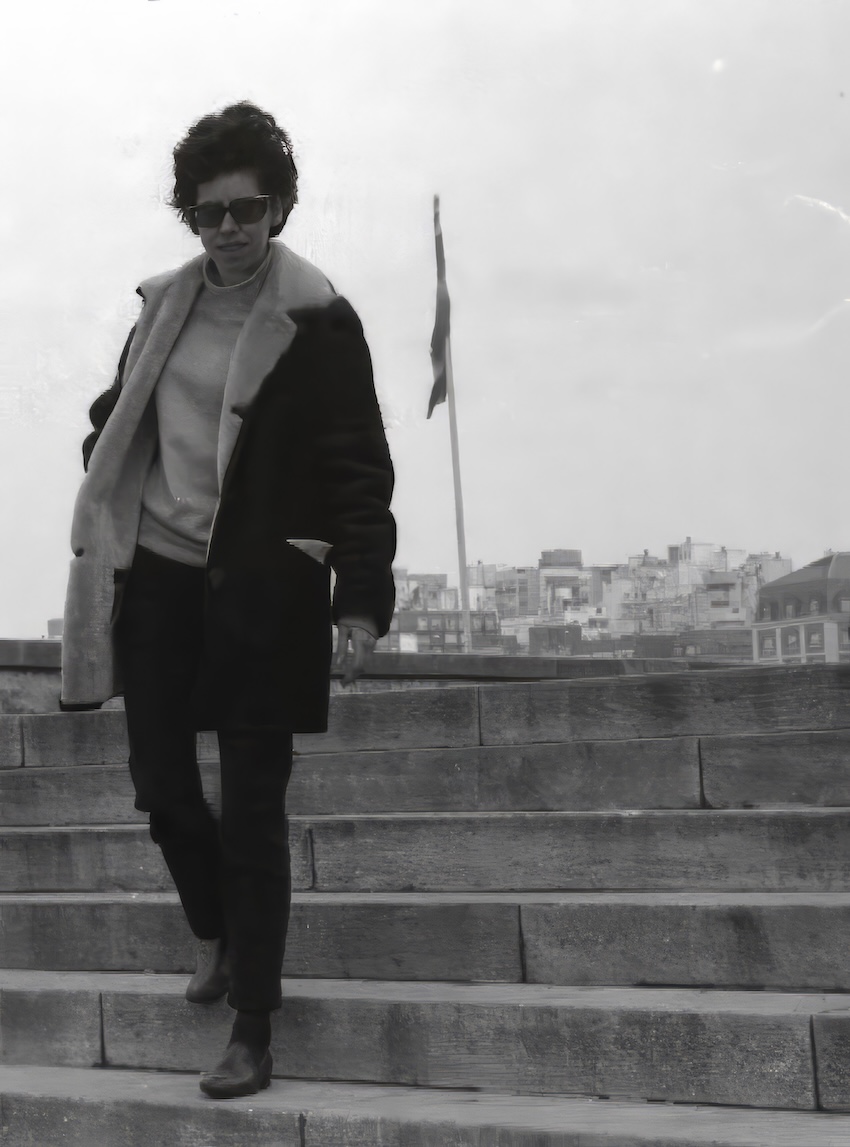
Lujáne Vaqar Pagganwala (Pakistan/United Kingdom)
“Anatomy Of A Breathing Exercise” (2024)
Anatomy Of A Breathing Exercise acts as a sonic representation of an attempt to materialize intimate spaces of the Self and its belonging. Stemming from the artist’s Humming Project, the sounds from the harmonica in the work were the results of a series of breathing exercises she performed while placing the harmonica in her mouth. The artist uses methods of spatial categorization as metaphors for comprehending our internal psyche and cognition. Anatomy Of A Breathing Exercise was made as a sonic extension of the Home Series. Inspired by Pauline Oliveros’s “Deep Listening”, the piece is multi-layered with sounds from the artist’s roof in London/Karachi, notes of a harmonica, and a distant lullaby. For Pagganwala, her roof acts as a parallel to the deepest part of the psyche; the unconscious. This characterization is a metaphor for the intangible spaces of existences that we move through as beings. These are spaces of uncertainty and latency. While listening to this sound-bath, we exist across all these layers. We travel to each sound and back, constantly oscillating between these planes. Each sound forms a space. Each space holds an existence of our-self. More so, the piece is meant to have an effect on the listener’s breathing while they experience the sound, thus the work holds a performative nature as well.
Lujáne Vaqar Pagganwala is a multidisciplinary artist with a profound affinity towards towers, structures, ladders and the like. She investigates the phenomenology of space, as an idea and as a physical entity. Pagganwala’s practice explores abstract existences on multiple spatio-temporal planes at once, and our omnipresent transience across these spaces. Taking inspiration from childhood spaces as well as urban topographies, she creates hybrid realities that are playful, layered and confrontational. The interactive nature of her practice layers these experiences into an ever-lasting loop of curiosities and becomings. A co-existence of amalgamated energies in flux – a Flash Space, as she refers to them. Pagganwala received an MA in Contemporary Art Practice from Royal College of Art, London, and continues to work mainly between the UK and Pakistan. She has exhibited both nationally and internationally across major institutions like Tate Modern, Copeland Gallery, Canvas Gallery, Koel and many more. Pagganwala witnesses her practice morph and mutate whilst moving between different geographical states. It is a mobile practice, forever in transience, and forever curious.
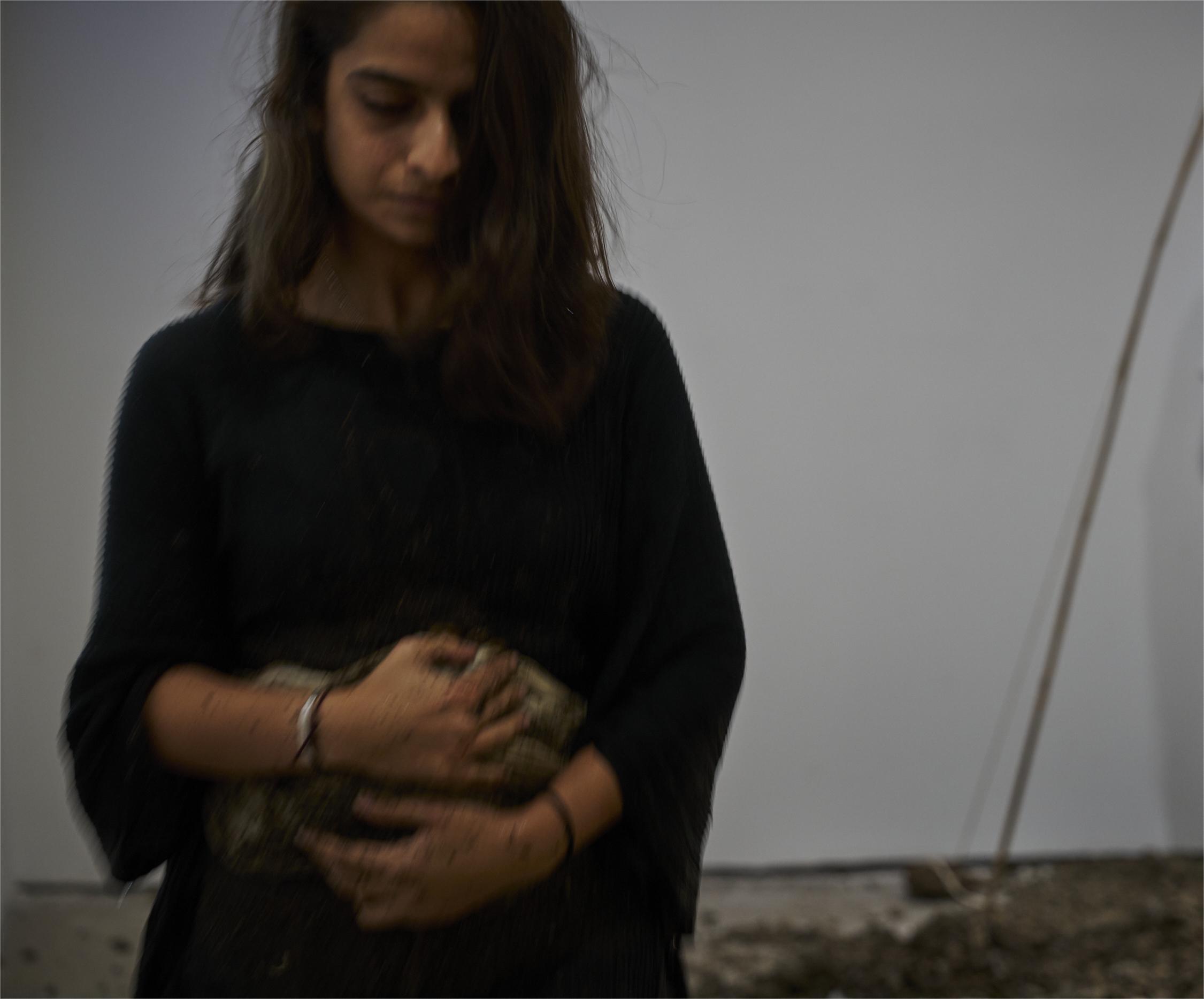
Amanda Piña (Chile/México/Austria)
“To listen with the hands. A practice for decolonizing the senses” (2025)
This is a practice, a guided trip, an experiment in the decolonization of the senses. It works through sound on how touch and attention can transform the way we feel, think and be. On how the senses can be used otherwise and what this does to our perception. In my work I often do guided practices that aim at transforming the way we think, understand and feel our bodies. There is so much to transform today, as we realize that we won’t be able to repair our house, the earth, with the same tools that brought about its destruction. I propose to start with the body, to transform our bodily experience. These times invite us to be portals, to allow other ways of being to arise, other ways of relating with the world to manifest, less violent, less extractive, less fearful. This is practice to transform the way we think-feel our bodies, to unlearn outdated modern/colonial paradigms that are causing this socioenvironmental crisis. This piece is just a practice, to do with the space and with others, to explore the senses, to undo colonial temporalities, to listen, to be present, to listen with the hands. I hope you have a good time; I hope you go for it and dare exploring I hope we can become portals together.
Credits: The sound is called “warm up”, and was created by Swiss artist Christian Mueller as a warm up for my work. My voice and the sound were mixed by Chilean artist Marcelo Daza, and perfected through many different teaching situations with many students and workshop participants in the last ten years.
Amanda Piña is a Chilean-Mexican-Austrian based artist living between Vienna and Mexico City. Her choreographic work is concerned with cosmopolitics, including performance, music, video and sculptural works that exist in the context of the theater, the museum and beyond. Piña is a multifaceted artist working through choreographic, performance and dance research, creating, curating and teaching within university and artistic educational frameworks, writing and editing publications around what she refers to as “endangered human movement practices”. Her work is grounded in indigenous forms of knowledge and world making/maintaining practices. Her work has been presented, in theatres, galleries, museums and cultural centers around the world, such as Tanz Quartier Wien, Kunsthalle Wien, MUMOK Museum of Modern Art Vienna, deSingel Arts Campus Antwerp, Fondation Cartier pour l’Art Contemporain Paris, Museo Universitario del Chopo, México and GAM, Santiago de Chile among others. In 2024 she was awarded the Valesca Gert Chair of Choreography at the Free University Berlin.
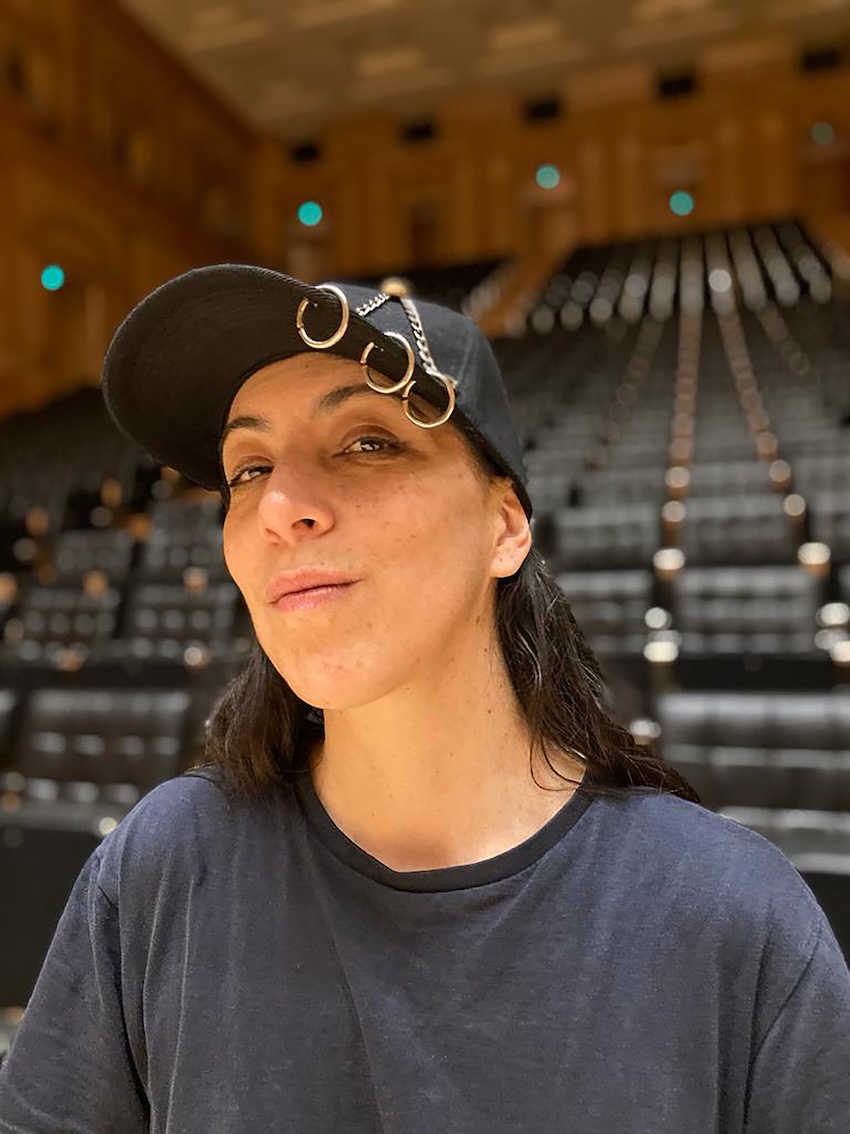
Ruhail Qaisar (Ladakh)
“ZANGRNAMS” (2025)
“In front of me the primeval sky, void, emptiness
A black wind rises and swirls, fire blazes
The fierce red spirit of the gorge appears before me
In the centre of his forehead the eye of primordial awareness
Donning a scarlet cloak, he stands atop a red godly horse
He stabs my heart
And blood spills forth like the currents of an ocean”
The idea behind this composition stems from the myth of Seven Demon brothers or Tsan deities, who came from Kham (Eastern Tibet) and settled in Ladakh as protectors of monasteries and oracles. The composition is named after the youngest of them, Zangrnam, a fierce God, demanding blood offerings three times a year—legend stretches out to say that this deity ordered the heart of an eight-year-old child, and the sacrifice was replaced later by a white goat. Nowadays, a piece of meat is used as a substitute, at the end of the Skurbuchan village under a juniper grove. This composition is a sonic interpretation of this ritual act, the horrors, and the dramaturgy of this certain cruelty.
Ruhail Qaisar is an artist from Leh, Ladakh. His current practice revolves around examining threads of local memory, mythos, and poetics through sound art, compositions, and found sculptures. Involved within various cross-genre projects since 2015, his early noise shows all over India are recalled as sonic palate-cleansers. He debuted with his concept album Fatima (2023), dubbed by The Quietus as "haunting", released on Danse Noire featuring Dis Fig and Elvin Brandhi, with a 48-page photo book publication. The commissioned hymnal piece for Les Urbaines written in collaboration with Gottfrid Åhman and Michael Anklin, Three Hymns of Cruelty (2022), which delved into the dynamics of Ladakhi procession music, was performed at Arsenic in Lausanne. His found footage VHS short film Cenacle 97-98 (2022) was screened at the Zurich Kunsthalle, La Becque, and Gessnerallee Zurich for Parasite O Sinensis. His latest work Gods Erupt Like Tumors is a series of found sculptures and a monophonic sound installation on view at the Salts Gallery in Birsfelden, Basel CH. He recently finished his residency in Graz, Styria, preparing a 36-channel third-order ambisonic composition, Namkhay Rtsima / The Spine of the Sky, for the Musikprotokoll Festival for ORF (Österreichischer Rundfunk) and the Steirischer Herbst ’24 at the Dom im Berg.

Superlative Futures (Singapore)
“听潮 [the sound of impermanence]: Finding Putuo” (2025)
15 February 2025, Singapore.
7.30pm, low tides at +0.30m.
We left the city in the hope of finding Putuo—but not the geographical place of the mountain (that is also an island) as the name refers to. Instead, it was a metaphorical Putuo that we found in the shifting edges of an intertidal landscape that comes visible in the low tide once or twice a month. The rhythmic sound of the tides receding and then returning up-shore recall the cave at the foot of Putuo where the changing tides could be heard. It was there, as a story tells, that the Bodhisattva Avalokiteshvara Guanyin (whose name translates as the “Observer of Sounds”) gained enlightenment by listening to the coming and going of the tides.
Finding Putuo (2025) is a 15-minute soundwork looping in a cyclic recounting of the artists’ bodily translocations from city centre to coastal periphery, and back again. When the tides become audible, the grounded-ness of the concrete-city dissolves underfoot to muddy material impermanence. The artwork is a call to pause and observe the sounds of the tides amidst daily life. Each coming and going is an opportunity to find our little Putuos.
Superlative Futures is a transdisciplinary design and research agency in Singapore and is co-founded by Wong Zi Hao and Liu Dian Cong. The research practice centers on creative modes of representation to advocate new ways of seeing landscapes and speculate alternative social imaginaries and futuring practices for cities to relate better with more-than-human worlds. They see their design output as a practice of care. They have exhibited at NUS Museum and were supported by Singapore Art Museum’s inaugural Design Research Fellowship, 2024–2025. Wong received his PhD in Architecture at the National University of Singapore in 2023, having completed a design-led research on intertidal practices of care. Alongside his research practice, Wong teaches at NUS’ Department of Architecture, and the University of Arts (NAFA)’s Design Practices program. Liu currently practices as an architectural designer, after completing his Master of Architecture at NUS in 2024, exploring sedimentation and alternative conceptions of “ground”.
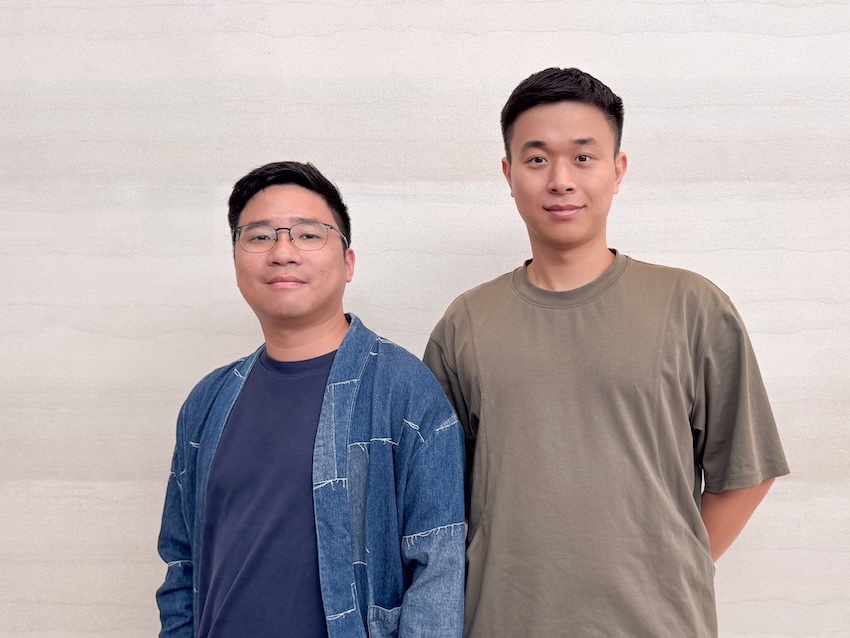
Irazema H. Vera (Peru)
“Puna (Del quechua, del māori)” (2025)
Es manantial y también la región de las alturas andinas. El inicio, la fuente que fluye, la ligereza de estar cerca del cielo. / It is a spring, and also the region of the Andean heights. The beginning, the flowing fountain, the lightness of being close to heaven.
In this piece, I explore the sounds of memory and connection: the ones with our origins, the ones with the world we live in, the ones related to our traumas, and the ones that call our spirit back to continue. Like in Children of the days, Eduardo Galeano mentions, for August 11th, my birthday, in his interpretation of the sense of family/whānau/ayllu in indigenous wisdom:
“...
Your family also speaks to you in the crackling of the fire,
in the murmur of running water,
in the breathing of the forest,
in the voices of the wind,
in the fury of thunder,
in the rain that kisses you,
and in the birdsong that greets your footsteps.”
—Eduardo Galeano, Children of the days
In Aotearoa, whenua is used to refer to both the land and the placenta. Thus, Puna, my daughter, coming out of the universe-belly-hapu leaving the whenua and being embraced by another whenua, finding the source, finding la puna.
Recordings made in Te Awanga, Lake Waikaremoana and Auckland (Tāmaki Makaurau) in Aotearoa New Zealand; and in Puno, Caritamaya (Nación Aymara), Chua Chua (Nación Q’ero) and Lima in Peru; between November 2019 and February 2025.
Irazema H. Vera (Puno, 1983) is a Peruvian artist, musician and musicologist. Her work revolves around memory, music and territory; and spans sound engineering, music production, documentary & narrative podcasts, sound art and research. She uses field recordings and soundscapes as starting points in the different paths of her artistic practice in which memory is expressed through the testimony of the human voice, music and the sounds of vulnerable and transgressed territories. Her compositions include musical traditions and landscapes of the Quechua and Aymara cultures of the Puno highlands where her cultural heritage is from, and has been featured on SONODOC Latin America, Radio AlHara in Palestine, RRFM in Holland, Común Radio in Peru, Cities and Memory in the UK, and compilations from label MATRACA (Peru-Mexico) and Eck Echo (Peru-Berlin).
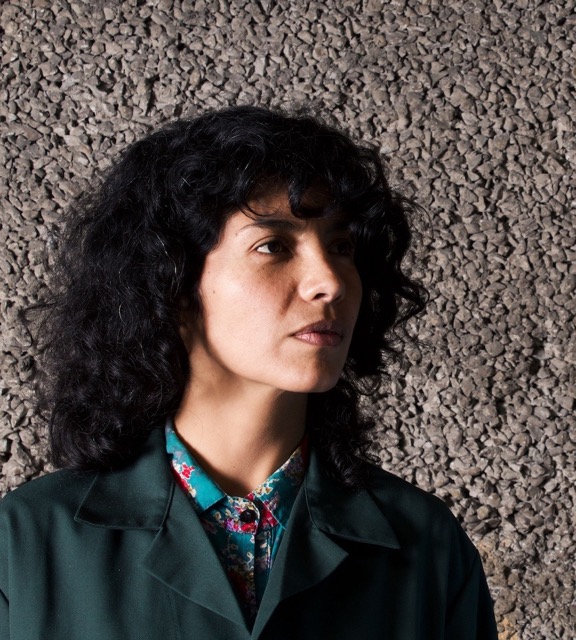
Valentina Villarroel (Chile)
“They are my voices” (2025)
They are my voices,
fragments of an infinite fabric.
I merge with the whisper of the leaves,
with the distant song of the trains,
with the liquid cadence of the rain.
I imitate, I repeat, I reinvent myself.
Valentina Villarroel is a sound artist and phonographer who explores the intricate dynamics within various southern ecosystems. Her work revolves around the profound potential of acoustic ecology, particularly in the face of encroaching real estate development on natural spaces. She also delves into the consequences of sound pollution on numerous species, contributing to their decline or disappearance. In recent years, her focus has extended to urban soundscapes and significant sonic events, such as the October 18th protest in Chile. She has a solid background in bioacoustics applied to both human and animal well-being. Her albums delve deep into the world of audible and inaudible soundscapes and their ability to give us an alternate knowledge of reality.
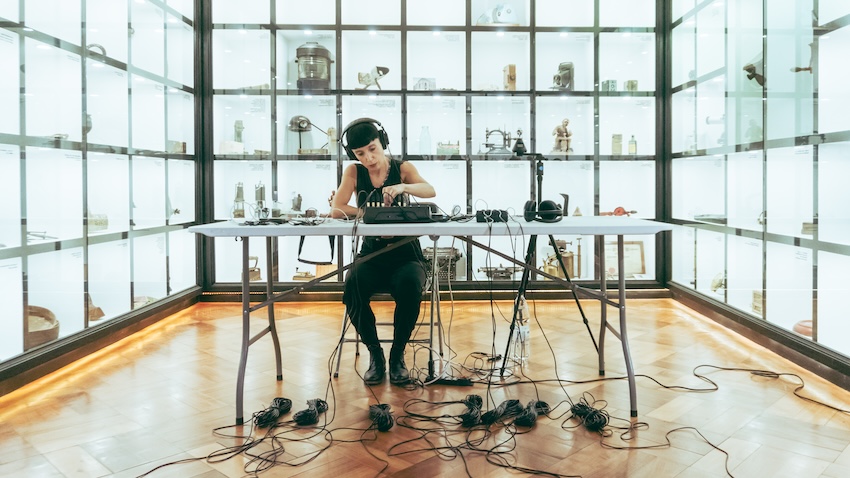
YIM Sui Fong (Hong Kong)
“Black Ghost Trail” (2025)
How can sound or sound play conjure memories or re-materialize feelings of a place? Inspired by the childhood experiences of a resident from the local Hakka village of Chuen Lung in Hong Kong during the 60s and 70s, this work explores his young life among natural and man-made elements, such as a stream from Tai Mo Mountain, a hill road full of wind and pine, and the surroundings of a graveyard.
For city dwellers, the ability to interact, play, and sense various species seems lost. Can we reclaim this openness as a resistance to homogenized urban life? By taking sound as a carrier to weave together the past and present, and as a way to participate in the village memory, I use field recordings to document and reassemble Chuen Lung village. This includes searching for hints, creating games, playing, and wandering to elicit new reactions. The editing process acts like a recurring sound play, evoking ghostly childhood memories.
YIM Sui Fong is a Hong Kong-based artist and assistant professor at The Chinese University of Hong Kong whose practice bridges socially engaged art, collective learning, and sound. Through participatory listening environments and sound-based installations, she activates memory and shared agency—drawing on oral histories, minor archives, and site-specific soundscapes. Her work frames sound as both a medium of resistance and a method of collaborative knowledge production. A co-founder of Rooftop Institute, she advocates for art learning as a mode of social engagement. She also serves on the board of HASS Lab, promoting artist-led approaches to social inclusion, and is one of the initiators of Ecologies of Participation, a transdisciplinary platform bridging practice-based creation with civic engagement. Recipient of the Hong Kong Arts Development Award for Young Artist (Visual Arts) and the WMA Masters Award, Yim’s practice exemplifies how socially engaged sound art can catalyze exchange, amplify the underheard, and rehearse new forms of collective memory.

zeropowercut (India)
“bujhat naikhe / can’t understand” (2024)
Written as a reflection on masculinity, the song is about a person scouring for themself in a straw hut they have built. The song, in Bhojpuri language, explores Nirgun: a form of thinking and singing (an art form and a philosophy). Briefly put, Nirgun is to recognize the world and things as ungraspable, and thus, to practice intelligence (and intelligibility) via materiality and experience. This original song is part of a theatre production, a musical titled Lattar [vine] which explores the lives of Naach or Launda Naach artists, infamous in this patriarchal and caste-feudal world for their practice of men becoming women. The song is performed (vocals and music) by Sunaina, a retired Launda Naach artist, and written by Raju Ranjan, a theatre professional and singer-performer, in collaboration with Piyush Kashyap, an independent researcher and artist. Lattar was commissioned by Maraa: a Media and Art Collective based in Bangalore, India for their 2024 October Jam titled “Stone Flowers”. zeropowercut also thanks Sipahi, a Naach artist and co-member of Lattar team, and Puneet, who generously provided shelter and food during the making of Lattar.
zeropowercut makes art to locate how oppression hides in the mundane. They talk about self-abjection and dissociation, focussing on the aspects of caste-based oppression {sudra-fication} that erases, from immediate to historical and civilization fields, working people’s capacity for experience and knowledge. Living and working from hegemonically marginalized and deprived worlds-of-our-origin, zeropowercut makes works individually as well as collectively, often transforming sites of production as intersections of otherwise segregated socialities and cultures. zeropowercut works with everyday objects, sayings, language, sound, and atmospheres to make installations, interactions, songs, theatre and research-presentations, using mostly modes of speech, documentary, and essay.
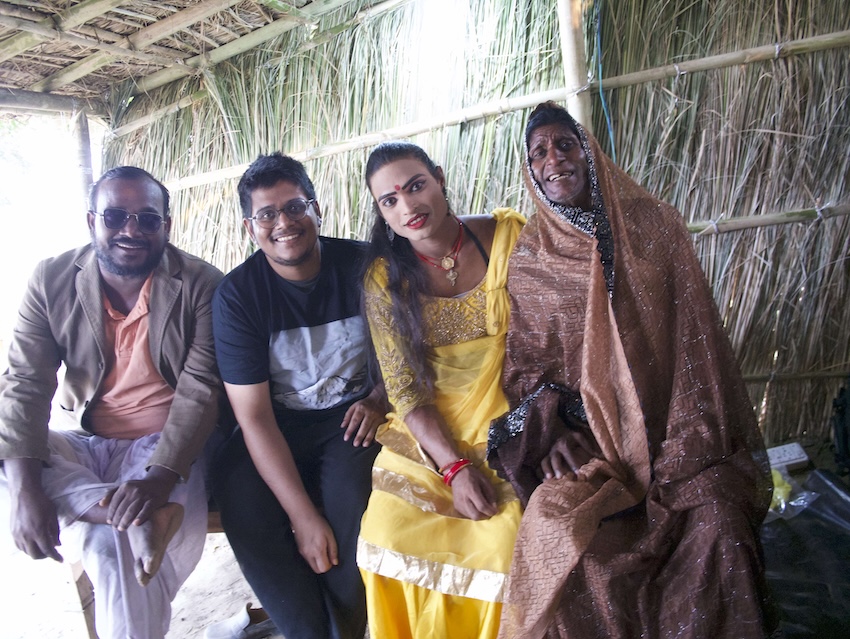
~pes (Colombia/Germany)
I Build My Language with Rocks: Ash Rain (2022–ongoing)
I Build My Language with Rocks: Ash Rain attunes to the grain of the earth’s voice, where language is not spoken but trembled into being. What does it mean to listen to the deep, resonant vibrations of a volcanic archipelago? In resonance with Édouard Glissant’s archipelagic thinking, ~pes evokes basaltic assemblages and their rhythmic intensities as part of the planet’s formative processes—its seismic breaths, eruptions, formations, and dissolutions that surge from and within the earth’s core.
To conceive these processes as a language lies not in metaphor or representation, but in their capacity to articulate and inscribe material transformation and temporal depth. Vibration, then, is engaged as an embodied modality of relation that traverses bodies and matter, emerging with the ongoing planetary reconfiguration, where creation and collapse unfold in a continuous dynamic drift. These are not discrete events, but evolving processes through which we come into relation with the earth’s deep time.
~pes is a collaborative artistic research process between Bogotá-born and Berlin-based Elizabeth Gallón Droste and Pablo Torres Gómez. Through site-specific investigation, ~pes evokes multimodal encounters with the interspecific weave we are part of, enacting partial encounters with divergent temporalities and beings in processes of becoming. The process questions and exceeds conventional, close-ended representations of planetary ecologies, fostering attunements to the murmurous and subterranean worlds that constitute them. These collective encounters and imaginative processes take the form of sound walks, listening sessions, installations, written texts and sonic releases.
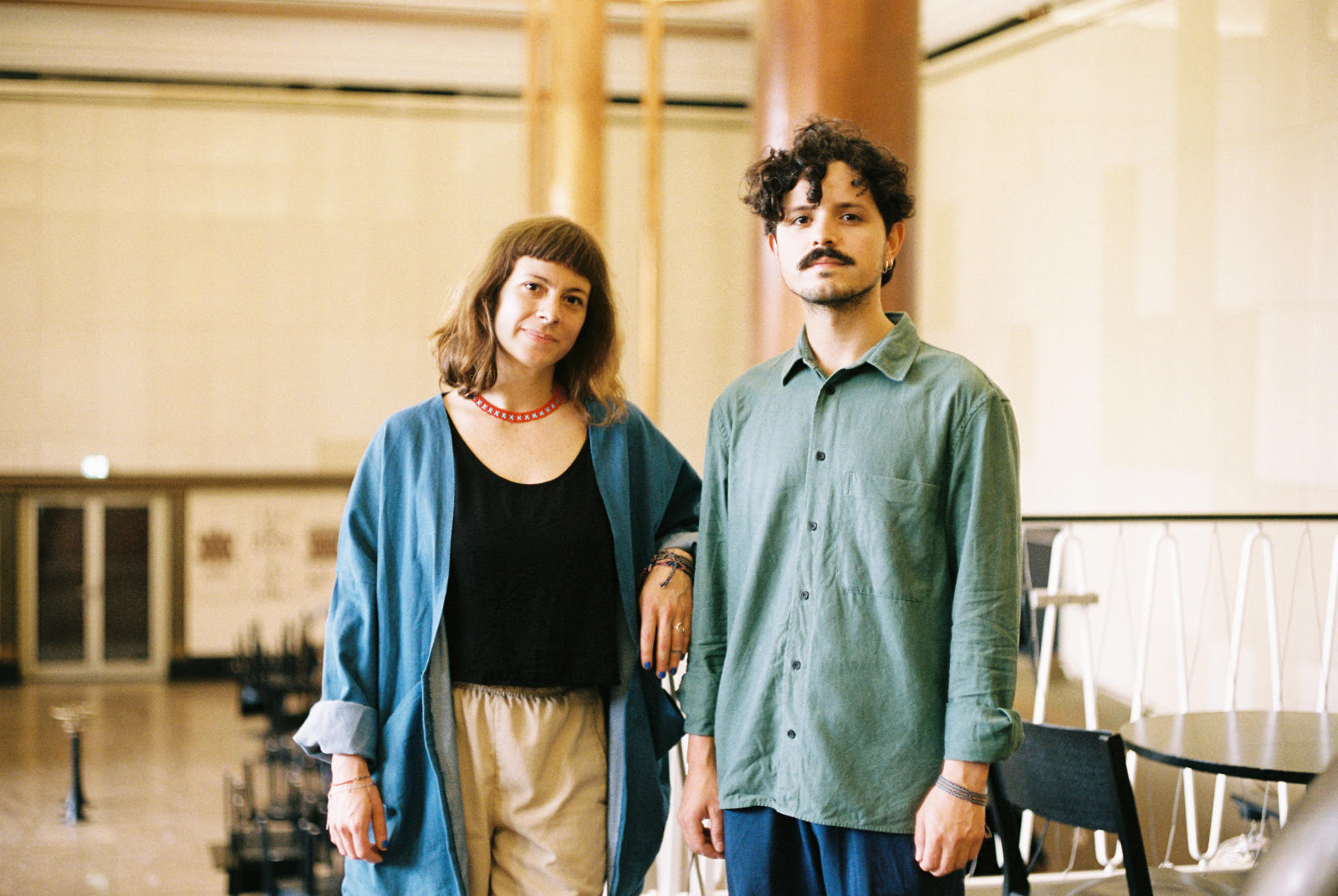
Radio CASo is a community experimental radio for sound research and exploration, broadcasting from Argentina to Latin America and the rest of the world since 2020.
Radiocaso.xyz
Espacios del Arte Sonoro is a research project at Universidad Nacional de Tres de Febrero. It operates as a transdisciplinary platform that explores the relationships between space, sound, and listening practices through artistic, philosophical, and technological approaches. https://artesonoro.untref.edu.ar/es/espacios-del-arte-sonoro
The San Martín Cultural Center is a landmark space in the City of Buenos Aires, dedicated to the dissemination, experimentation, creative research, and production of knowledge around contemporary artistic and cultural practices. Inaugurated in 1970 and designed by architect Mario Roberto Álvarez, its modernist architecture and history make it a cultural reference point at both national and international levels. https://elculturalsanmartin.ar/
Centro del Sonido (@centrodelsonidoperu) serves as the main partner for La Bienal de la Escucha / Lima, bringing its established platform for experimental music and sound art to the international biennial network. Centro del Sonido organizes events around sound throughout Lima and Peru, connecting the country's experimental music community through its networks and programming. The Lima edition of The Listening Biennial 2025 is organized by Nicolás Kisic Aguirre, an architect and transdisciplinary sound artist, and Luis Alvarado, record producer, curator, and director of both Buh Records and Centro del Sonido, in collaboration with Lima's diverse sound communities and cultural spaces.
The Pereira Palace is a historic monument opened to the community in 2021 following its restoration (2016-2019) after decades of material deterioration. Its mission is to promote tangible and intangible heritage, hosting temporary exhibitions with three main lines of action: giving visibility to public collections; generating initiatives that allow for the dissemination of knowledge, memory, and local history; and promoting the use of the space through a public program with active citizen participation.
https://palaciopereira.cl/
The Parque Escuela/ School Park is a community, ecological, and educational park that emerged from the transformation and cleanup of a garbage dump that collapsed from contamination following the 1975 fire at School 36. The initiative to create a biodiverse park was driven by the local community, who in 2015 managed to transform the uncontrolled waste into a meeting place. Through the support of the community itself and various universities in the region, the park has been able to include a walkway for people with reduced mobility and senior citizens, playgrounds for children, and a community garden. The park’s current caretakers are associated through the community organization META, made up of artists, educators, community psychologists, and environmental and sound engineers.
https://www.instagram.com/parque_escuela/?hl=es
La Puerta Azul is a new cultural center, forum and residency space based in the idyllic Chapala Riverbank. A place where sound arts, experimentation and community converge.
Located in the heart of Quebec City's Saint-Roch district, L'École d'art de l'Université Laval offers an inspiring learning environment, in constant interaction with numerous art centers, galleries, workshops, and theaters that collaborate on its learning objectives. The dynamic, thriving cultural network of the city center stimulates creativity, fosters encounters, and facilitates the acquisition of professional experience. The specialized workshops and laboratories are equipped with state-of-the-art equipment allowing for work in digital and film photography, carpentry, molding, engraving, lithography, metalwork, screen printing and sound art.
L’Œil de Poisson is an artist-run center and a major player in the Quebec and Canadian art scene. It encourages creation, production, and dissemination in the visual arts through its technical workshops open to the community, as well as its two exhibition spaces with unique formats. It supports both emerging and established artists and curators, contributing to their influence in Quebec and internationally. The center offers various services: spaces for residencies, technical support, as well as specialized locations facilitating the production of works of all scales.
Musicmatters is an institute which offers a performance based, alternative music education. Musicmatters was started in 2010 to introduce an alternative model for music education in Sri Lanka. In contrast to conventional exam-oriented instruction methods, they develop students' creativity and skills through a practical approach and enjoyable learning environment. Instead of exams, students are given frequent opportunities to perform in solo and group concerts in front of small and large audiences. This form of music education enhances self-esteem, emotional wellbeing, communication skills, creative thinking, discipline, patience, and teamwork. Musicmatters is centrally located with purpose-built teaching and rehearsal studios and a community performance space for live music events. They partner with the local government and foundations to offer music education programs for children in low income settlements of Colombo. Musicmatters is committed to compensating teachers well and giving legitimacy to music as a profession
The Foundation for Indian Contemporary Art (FICA) is a non-profit organisation that aims to broaden the audience for contemporary Indian art, enhance opportunities for artists, and establish a continuous dialogue between the arts and the public through education and active participation in public art projects and funding.
Khoj is a not-for-profit contemporary arts organization based in New Delhi. Through our programs we support and incubate emerging, experimental and transdisciplinary creative practices and pedagogies. Since our inception in 1997, we have been committed towards building global networks and solidarities, especially in the subcontinent. We believe that art is of intrinsic value to society; it is a crucial form of inquiry that provides unique insights and drives change through affect.
Uncanny Stations is an initiative that I have set up now. It's been on my mind for a while but just getting started with turning my home/ studio into a space for hosting gatherings. The LB becomes a way for me to begin shaping it slowly, one instance, one station, one assembly at a time. The space will become a hub for generating the glossary of Third listening, collaboratively with others via discussions, readings, screenings and propositions.
soundpocket is a promoter, educator, facilitator, and gatherer. We work in the fields of sound, art and culture. We find sound in diverse and dynamic relations with many different art forms (visual art, installation art, music, theatre, dance etc.), and with a variety of cultural contexts that give meanings to our lives. We would like to work with all those who share this active interest in sound.
soundpocket supports not just an art form, but ideas and possibilities that engage with aesthetically meaningful, culturally-grounded and publicly relevant sonic practices, which have a lot to teach about how we understand the world and the experiences yet to be valued.
https://www.soundpocket.org.hk/v2/
TheCube Project Space, founded in 2010 in Taipei, is an independent art space dedicated to the research, production, and presentation of contemporary art. As a non-profit organization, it focuses primarily on sound culture and contemporary curatorial practices, while actively exploring local cultural contexts, fostering connections among diverse communities, and building long-term collaborations with artists to facilitate cultural exchange between Taiwan and the international scene. By 2024, TheCube Project Space has organized over 70 exhibitions and more than 100 lectures and performances. Its research outcomes have been published in various formats, including archival websites, publications, online radio, and art festivals. The space has also collaborated with over 200 artists, researchers, and cultural activists, alongside partnerships with mid- to large-scale galleries, museums, and international institutions.
https://thecubespace.com/
Based in Jakarta, Sigisora is a listening initiative that explores everyday soundscapes through site-based research & practice as a medium to study their social, cultural, and ecological contexts. Through methods such as sound journal, soundwalking, field recording, cataloging, composing and organizing listening sessions, Sigisora traces environmental and spatial shifts foregrounding the relationship between human and nonhuman presences. Sigisora listens closely to the multilayered sounds of the tropics, which emphasizes ethical engagement in encountering places, communities and histories.
Forum Lenteng is an egalitarian non-profit organization as a means of social and cultural studies development. Forum Lenteng was founded by communication students, artists, researchers and cultural observers in 2003. The forum was established to develop knowledge on media and art, by doing production, documentation, research and open distribution. The development of this knowledge then becomes the foundation for the community to discuss social issues through artistic mediums. Since its conception, Forum Lenteng has evolved by developing many programs with support and cooperations from various institutions and communities in Indonesia and internationally. To achieve these goals, Forum Lenteng has 2 major focuses of programs, namely, (1) Development, Empowerment and Inter-Community Network Development and (2) Deployment and Distribution of Information and Knowledge Through Media.
https://forumlenteng.org/id/
The Centre for Contemporary Art (CCA Lagos) is an independent non-profit visual art organisation founded in December 2007 by Bisi Silva (1962 – 2019). The centre is a platform for the development, presentation and discussion of contemporary visual art and culture. It seeks to create new audiences and prioritises under-represented media such as photography, film and video, performance and installation art in the Nigerian art landscape.
https://ccalagos.org/
A self-organizing platform engaging with sound-related artistic and research projects in Egypt.
AVTO is an operating system working across the field of culture, providing interfaces dedicated to knowledge production. Founded in 2017, AVTO aims to serve as a utility-oriented, mutable organizational model open to all. Developing experimental methods and subjective thinking in art, design, architecture and social sciences, AVTO’s outputs are in diverse media such as podcasts, exhibitions, documentaries, research projects, and publications. The organization has a multi-functional space located on Kazancı Yokuşu Street near Taksim Square. Occupying the basement floor of Emek Apartmanı, AVTO offers a modest setting without fixed functions. Designed by artist Can Altay in 2021, the facility seeks to constitute a living, malleable environment accommodating different needs of users.
https://avtoonline.org/
Rabt is a nomadic space dedicated to connecting communities through collective engagement, centered around sonic practices. Rabt’s small yet growing library and archive are hosted by Shaahin Peymani and Maryam Katan (Tehran Limits), where Rabt’s events in Iran also take place. Initiated in Tehran in 2020 by Golnoosh Heshmati and Sohrab Kashani, Rabt functioned as a transdisciplinary and collaborative studio until 2024 before transitioning to its current nomadic format.
https://rabtspace.org/
Ballhaus Ost in Berlin-Prenzlauer Berg is a venue for independent theater, performance, dance, music theater and music. As an experimental stage for a wide range of forms of contemporary theater, it invites audiences to experience and discover new ways of artistic engagement with contemporary realities. Both aesthetic approaches and thematic scope are characterized by a socio-critical attitude and the search for alternatives to normative structures. Urbanity and locality, surprises and challenges, history and queerness, narration and documentation are represented in the program as well as a variety of exciting works for non-German speakers.
Located in the former celebration and assembly hall of the Freireligiöse Gemeinde Berlin, that was built in 1907, Ballhaus Ost shelters many established, mostly Berlin based, theater groups and artists. At the same time, it offers lesser-known acts from Berlin’s vital independent theater scene space to present their work and develop new aesthetics. The program is complemented by guest performances from German-speaking countries and beyond.
Ballhaus Ost was founded in 2006 by the directors Uwe Moritz Eichler, Philipp Reuter and the actress Anne Tismer as a self-managed artists’ stage, after the hall had been used as a »casino of crafts« in GDR times and as a billiard salon and night club after the reunification. Tina Pfurr and Daniel Schrader have managed the venue since 2011 and developed it into an anchor institution for the independent performing arts in Berlin.
https://www.ballhausost.de/
When the DAAD Artists-in-Berlin Program founded the daadgalerie in West Berlin in 1978, it created a place for fellows from different cultural fields to engage with the city and its residents. Since then, the venue has remained the hub of the program’s activities in Berlin. In 2017 the daadgalerie moved to Kreuzberg—a district characterized by displacement as well as by a commitment to building a plural and diverse urban community. Since 2018, the two floors of the building on Oranienstrasse have been used to establish new forms of presentation, introduce transdisciplinary formats in association with current and former fellows, and implement initiatives aimed at local children and young adults. The daadgalerie program is developed in close cooperation with the fellows, as well as in collaboration with other creative practitioners, festivals, universities, galleries, museums, and cultural institutions.
Lydgalleriet is a production and exhibition platform for sound-based art situated in Bergen, Norway. We are the only specialized gallery for sonic cultures in Norway and our purpose is to promote and support sound-based art expression through dissemination, stimulation for new production, live events, collaboration and community building. Lydgalleriet was initiated in 2005 by a group of local artists, musicians, curators and art historians. They wished to explore how a traditional gallery space could benefit the presentation of sound-based art work, and how different acoustic environments can alter, modify or shape sound-based work.
https://www.lydgalleriet.no/
Fylkingen is an artist-run, non-profit association for experimental music and art. It was founded in 1933, making it one of the world's oldest forums of its kind. Today, the association consists of more than 100 active members who are developing and presenting new work across electro-acoustic and other forms of experimental music, dance, film, video, performance art and installations. It is run by an active board and programming group. In 2023 we relocated to a temporary location in Bredäng. Each year Fylkingen presents over a hundred events and continues to play a vital role in connecting artists and the general public in Sweden with contemporary artists throughout the world. Fylkingen also arranges events and activities for children and young people, often in collaboration with other organizations.
https://fylkingen.se
Simian is an independent art center in the district of Ørestad in Copenhagen, Denmark, founded in 2020. As an artist-run and a non-profit organization, Simian aspires to support and present experimental exhibition projects by national and international artists from emergent and established positions. Housed underground in a former bicycle parking facility, Simian offers a distinctive architectural and acoustic context for contemporary art.
https://www.ssiimmiiaann.org/
Mjølnerparken is a public housing development in Ydre Nørrebro, part of the Nørrebro district of Copenhagen, Denmark. Administered by Bo-Vita, the development contains 560 units accommodating 966 people as of 1 December 2023. The complex opened in 1987. Mjølnerparken is bordered by Tagensvej to the north, Midgårdsgade and the former railway yard (now Superkilen) to the east, Hothers Plads to the south, and Borgmestervangen and Mimersparken near Bispebjerg railway station to the west. It has been the subject of various social and political initiatives, and is current grappling with new policies in the country related to social exclusion and housing.
CAM-Gulbenkian is an art and culture centre with a collection of contemporary and modern art which includes the largest representation of Portuguese artists to date. The brainchild of Fundação Calouste Gulbenkian’s founding President José de Azeredo Perdigão and its board, CAM opened its doors in its original guise in July 1983, designed by Sir Leslie Martin and associates. A fully redesigned building by Kengo Kuma and associates was inaugurated in September 2024. Envisioned as a venue to house a collection of modern and contemporary art in 1956, CAM holds the largest representation of 20th and 21st Century Portuguese artists gathered to date. It was also meant to be a site where the work of emerging artists in all forms was to be presented; hence its name: Centro de Arte Moderna. CAM naturally became the home of ACARTE, an avant-garde multidisciplinary programme launched in 1984 by Madalena de Azeredo Perdigão. Nested in a new garden designed by Vladimir Djurovic, the new CAM hosts numerous presentations of its collection, as well as temporary exhibitions by emerging and confirmed artists, some being exhibited for the first time in Portugal. In addition to its classic exhibition spaces, CAM also features a gallery dedicated to sound art. With this launch, CAM is also proud to offer a comprehensive Live Arts programme, reflecting the eclectic artistic production of our times, as well as a Learning Space and many participatory projects.
https://gulbenkian.pt/cam/en/about/
AuralPluralities is a research network led by academics and creative practitioners dedicated to addressing, and extending upon, the “auraldiverse turn” in the Arts and Humanities research. We welcome all CHASE Studentship holders, across disciplines.
bruno is a Venice-based graphic design studio, publishing house and bookstore initiated in 2013 by Andrea Codolo and Giacomo Covacich. Concurrently with its activity as publisher, bruno works in editorial consulting, graphic design, art direction mostly for art and design projects. In addition, bruno functions as a space for book presentations and exhibitions.
https://shop.b-r-u-n-o.it/
The Sound Studies Hub (SSH!) is a research center at Università Iuav di Venezia (Iuav University of Venice). It is led by Nicola Di Croce, an architect, sound artist, and researcher who also holds a PhD from Iuav. The hub focuses on the intersection of urban studies and sound studies, using sound-oriented, qualitative, participatory, and creative approaches to inform urban planning and design. One of their research projects explores the sounds of commerce and their impact on public space in Mestre, Venice.
Easterndaze is a project that has explored and highlighted underground music from Central and Eastern Europe through a variety of channels, including radio shows (London’s Resonance FM, Cashmere Radio, Czech Radio station Radio Wave, Habitat.fm netradio), concerts, music releases (see our Bandcamp page for more) and our label, BABA VANGA) and this blog. Between 2016 and 2021, the Easterndaze x Berlin events happened in Berlin, bringing together Berlin-based and Central and Eastern European independent music collectives and labels for a series of events, installations, radio shows. Check here for more information about that.
https://easterndaze.net/about/
Established as an information and cultural center in 1957, over the years it has changed its role, expanded its fields of activity and actively participated in the presentation and creation of cultural and artistic content and reflection on cultural activities in Serbia and Europe. Numerous programs that were authentically created and organized in the Belgrade Cultural Center still represent some of the most significant cultural events in our capital city and the entire country.
https://www.kcb.org.rs/en-us/
Firefly Frequencies is a radio platform initiated in 2020 by Silvia Maglioni, Graeme Thomson, Nikolay Oleynikov and Alessandra Pomarico, that brings together artists, writers, musicians, filmmakers, theorists and other collaborators from many different countries. Around 2022, Stevphen Shukaitis/Minor Compositions joined the editorial team. For us radio is first and foremost a place of gathering where many voices can meet, mix, transform. A membrane, a communal body that perpetually reinvents itself through different modalities and temporalities, through the dimensions of creation and care and the shared powers of reception and receptivity.
Our radio is a fugitive dwelling place, a place that focuses powers of deep and affective listening at a time when our body and mind are often fatigued by technologies of connectivity, where the image and its performativity are predominant. A place that asks us to attune ourselves as much to the material body of sound and to the sounds and silences of bodies as to the contents of what they express and transmit. That fosters attentive drift, surprise, immersion, awareness and imaginative flight. A place of transversal co-learning that interweaves music, sound-art, poetry, storytelling, live performance, conversation, cultural and political debate and the construction of alternative knowledges.
Since documenta fifteen, firefly frequencies is part of the LUMBUNG inter-local community and broadcasts on lumbung Radio (https://lumbungradio.org) 4 times a week: Tuesday 9-11 pm, Wednesday 11-12 pm, Thursday 5-7 am, Saturday 2-3 pm (CET).
ARTDIS Singapore Ltd, formerly known as Very Special Arts Singapore, is a leading non- profit organisation dedicated to creating learning and livelihood opportunities for persons with disabilities in the arts. Started in 1993 by Ambassador-at-Large Professor Tommy Koh, ART:DIS organises art programmes, projects, collaborations, exhibitions and performances for persons with disabilities to reach for excellence and be relevant in the future. ART:DIS further establishes pathways in the arts for persons with disabilities to express themselves, gain confidence and be part of a community.
https://www.artdis.org.sg/
Established in 1997, Ethos Books, an imprint of Pagesetters Services Pte Ltd, creates fresh, different and enduring books that reflect the ethos of our changing times. We are an independent Singapore publisher of literary fiction, non-fiction and poetry. Giving voice to emerging and exciting writers from diverse backgrounds, we help foster an environment in which literature and the arts not only survive, but thrive. In short, we nurture the growing literary community in Singapore and Southeast Asia. Our authors and their ideas come first. By taking a collaborative approach to publishing, we bring each author‘s voice and vision to fruition. We are always open to new ideas: different ways of working and fresh ways of delivering the unparalleled satisfaction only a good book can bring.
https://www.ethosbooks.com.sg/
Established in 2003, Objectifs is a visual arts space in Singapore that is dedicated to film and photography. Our goal is to cultivate original voices in visual storytelling, and to inspire and broaden perspectives through the power of images. We do this by presenting a year round program of exhibitions, screenings, workshops, talks, mentorships and residencies, aimed at fostering dialogue about visual culture, and advancing the practice and appreciation of photography and film.
https://www.objectifs.com.sg/
The Singapore Night Festival will run for three weekends from Aug 22 to Sep 6, transforming the Bras Basah. Bugis (BBB) district into a vibrant celebration of light, art and culture.
LASALLE College of the Arts is the highest ranked specialist arts institution in Southeast Asia for Performing Arts, and joint top for Art & Design (QS World University Rankings by Subject 2025). The College offers 36 Diploma, BA (Hons) and postgraduate programs across the full spectrum of arts and design disciplines. A nurturing, interdisciplinary learning environment inspires the next generation of forward-looking and globally engaged creative leaders, who are mentored by a faculty of award-winning artists, designers, educators and researchers. LASALLE’s tradition of practice-led research sets the College apart as an international centre of excellence.
Tselinny Center of Contemporary Culture is a regional institution that aims to empower the local general public and enhances an intellectual community by building a dialogue within Kazakhstani latitude and therewith the wider central Asian perspective. Tselinny center unites contemporary artists, emerging theorists and scholars for open reflection and critical debate on its platform. Tselinny Center of Contemporary Culture was founded in 2018 by a Kazakh businessman and entrepreneur Kairat Boranbayev as the country’s first private cultural institution. The center has been operating since 2018 and will move in 2025 to its permanent venue at a former cinema building after which it was named. Tselinny’s artistic strategy is based on the symbiosis between two motifs of Here and Now, a combination of performative and research programme. Here is about Tselinny’s physical space where various formats of events are happening such as art projects, films programme, contemporary theatre, music and other experimental forms. Now is based on the research projects that are occurring in the moment and continuously in the future to create an intellectual space enhanced by engagements with artists, theorists and public intellectuals from various disciplinary, cultural, social and ideological perspectives. Tselinny center strives to continue regional cooperation and aims to strengthen the dialogue between the intellectual and artistic communities.
https://www.tselinny.org/en
aacehmmmmpprv Critical Listening Group is a reading group that meets periodically to read and discuss texts related to listening from a critical perspective. It was born organically from the desire to share a space for collective learning and research on the practice and politics of listening, both in the arts in general and in philosophy and the social sciences.
One of the most innovative developments in the city’s regeneration is the introduction of a kulturljudzon (KLZ) – a cultural-industrial sound zone – in the Sofielund area in 2021. In recent years, this industrial quarter has become a thriving hub for new grassroots developments in culture, leisure and community engagement, which co-exist alongside established industries. As the city expands outwards and upwards, this once-peripheral location has become more central in relative terms, and the establishment of the KLZ provides a focused and protected area for noisy activities. This process of sonic re-invention, the only one of its kind in Sweden, has been led by local community members in collaboration with municipal authorities for planning, culture, leisure and environment. Permitting noise levels of up to 85 dBA at source, this zone is designed to create conditions for industry, culture and leisure to develop a symbiotic sonic relationship.3Local planning documents ensure the retention of existing distances between the KLZ and the surrounding housing, thus preventing new residential developments in the area, and marking out a space where the bass-heavy sounds from clubs and rehearsal spaces can blend with the hum and hammer of factories and workshops, the clatter of freight lorries and the shouts and cheers spilling out from sports clubs and play parks.
We are Transients, a collective of sound artists in South Korea. We move, stop and dwell for a while in places and spaces as we explore and observe, touch and are touched by, invite and accept invitations from, those who make sounds. We listen with them as our aim is to imagine with them possible sonic futures of the world we are living together. Since 2024, Transients has been making sound installations, organising sound-related events and workshops, collaborating with other artists and organisations on commissioned sound works, documentary films, research projects. In 2025, Transients established Sonic Nomads, a nomadic sound art festival in Seoul that centers around field recording, deep listening, and the relationship between place and sound.
Scuola Piccola Zattere is a non-profit space for continuous education and research in the expanded field of contemporary arts. Its activities encompass exhibitions, commissions, residencies and fellowships, workshops, seminars, discursive and performative events, following an integrated methodological approach that encourages mutual influences among formats of study, production, and fruition. Open to the work of cultural practitioners from around the world, the activities of Scuola Piccola Zattere are aimed mostly at the artistic communities who live, study, and practice in the city of Venice.
For more on the curatorial concept of Third Listening, please see the essay by Brandon LaBelle.
Bachelard, Gaston. The Poetics of Reverie: Childhood, Language, and the Cosmos. Boston: Beacon Press, 1971.
Baker, Willa Blythe. The Wakeful Body: Somatic Mindfulness as a Path to Freedom. Boulder, CO: Shambhala Publications, 2021.
Benjamin, Jessica. Beyond Doer and Done To: Recognition Theory, Intersubjectivity and the Third. New York: Routledge, 2018.
Bhabha, Homi K. The Location of Culture. London: Routledge, 1994.
Blaser, Mario and Marisol de la Cadena. “Pluriverse: Proposals for a World of Many Worlds.” In A World of Many Worlds, edited by Mario Blaser and Marisol de la Cadena, 1-22. Durham: Duke University Press, 2018.
Calder, Gideon. “Listening, Democracy and the Environment.” In In-Spire Journal of Law, Politics and Societies (Vol. 4, No. 2 – 2009): 26-41.
Clément, Gilles. “The Planetary Garden” and Other Writings. Philadelphia: University of Pennsylvania Press, 2015.
Gumbs, Alexis Pauline, “Learning to Listen.” In Healing Justice Lineages, eds. Cara Page and Erica Woodland. North Atlantic Books, 2023.
Irigaray, Luce. The Way of Love. London: Continuum, 2004.
Khodyreva, Anastasia (A) with Taru Elfving and Yvonne Billimore, Jaana Laakkonen, Anu Pasanen, Nina Vurdelja, and Kari Yli-Annala. “Attempts at Spectral Listening.” The Listening Biennial website, accessed July 2024. https://listeningbiennial.net/discourses/attempts-in-spectral-listening
Kimmerer, Robin Wall. Braiding Sweetgrass: Indigenous Wisdom, Scientific Knowledge and the Teachings of Plants. London: Penguin Books, 2020.
Kochhar-Lindgren, Kanta. Hearing Difference: The Third Ear in Experimental, Deaf, and Multicultural Theater. Washington, DC: Gallaudet University, 2006.
López, María del Rosario Acosta. “From Aesthetics as Critique to Grammars of Listening: On Reconfiguring Sensibility as a Political Task.” Journal of World Philosophies 6 (Summer 2021): 139–156.
Minh-ha, Trinh T. elsewhere, within here: immigration, refugeeism and the boundary event. New York: Routledge, 2011.
Raffo, Susan. Liberated to the Bone: Histories, Bodies, Futures. Chico, CA: AK Press, 2022.
Smilges, J. Logan. Crip Negativity. Minneapolis: University of Minnesota Press, 2023.
Weber, Andreas. Enlivenment: Toward a Poetics for the Anthropocene (Cambridge, MA: The MIT Press, 2019.